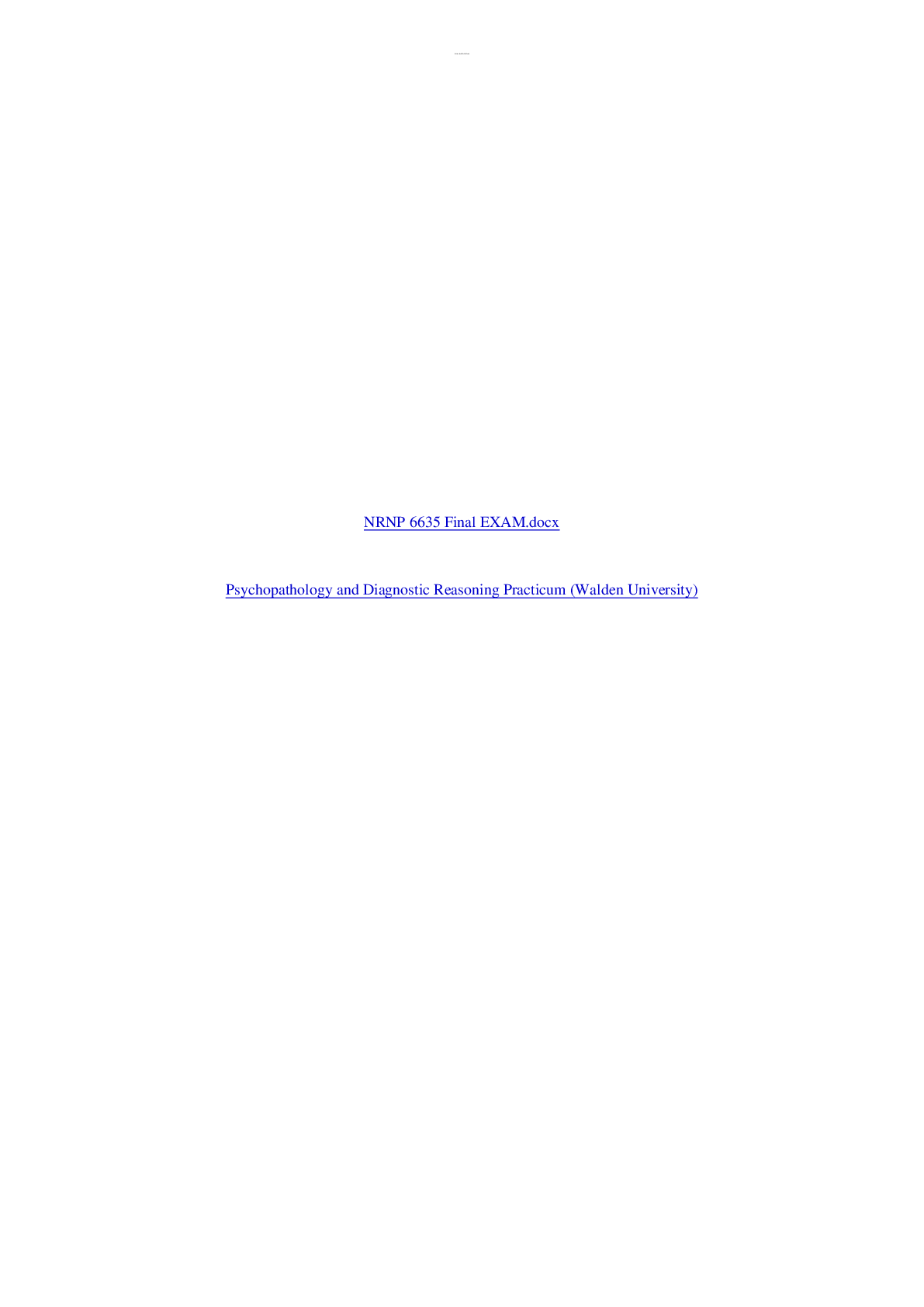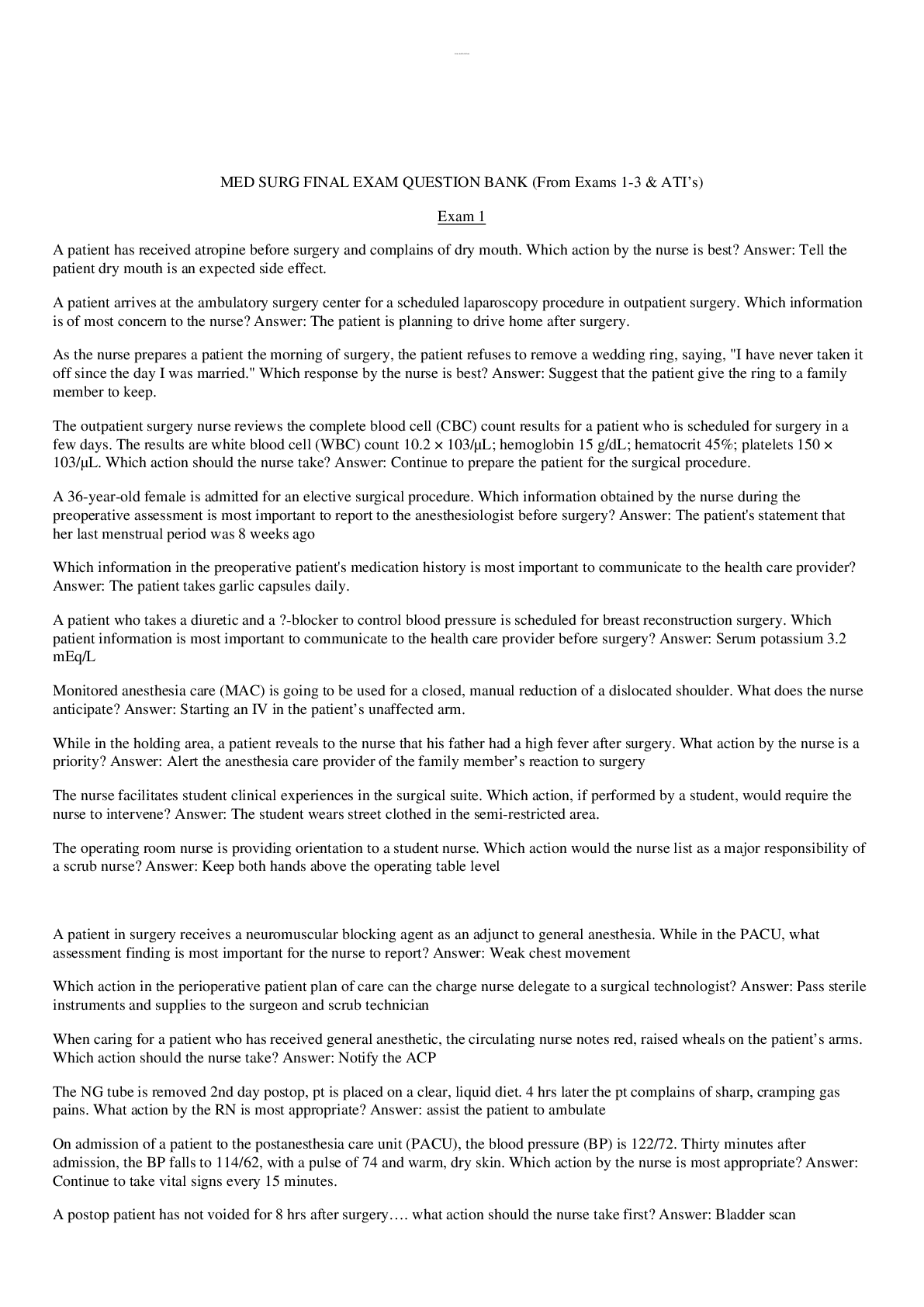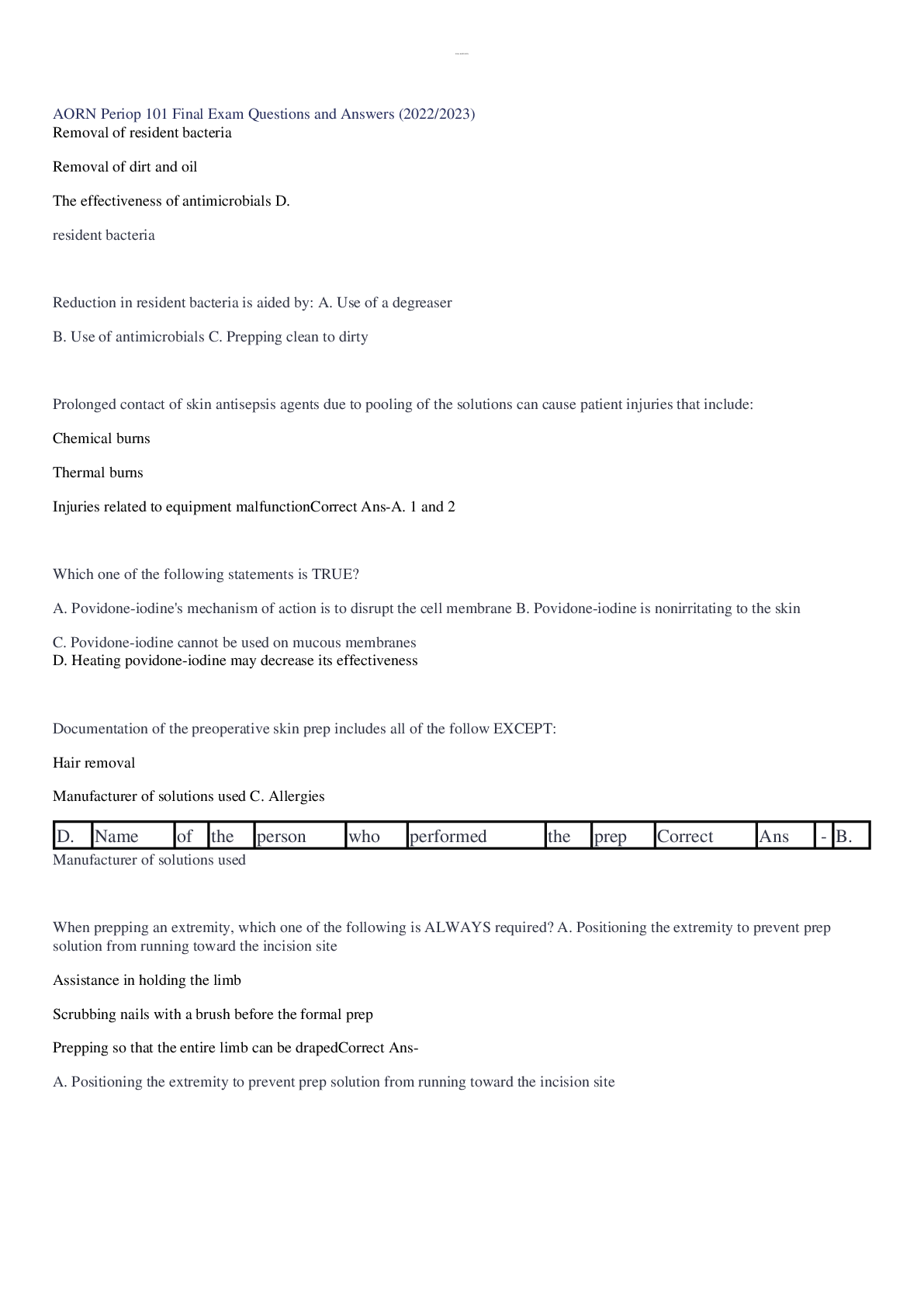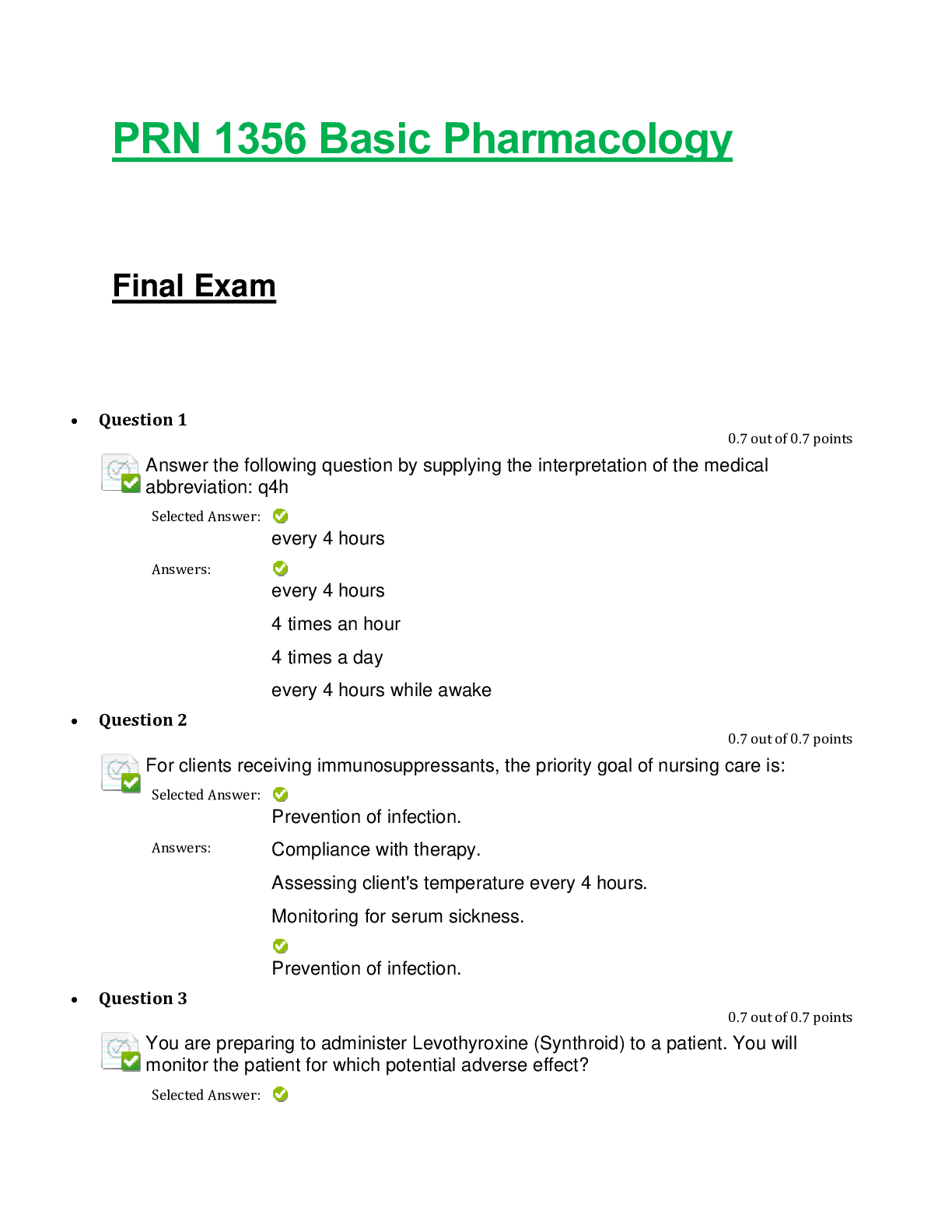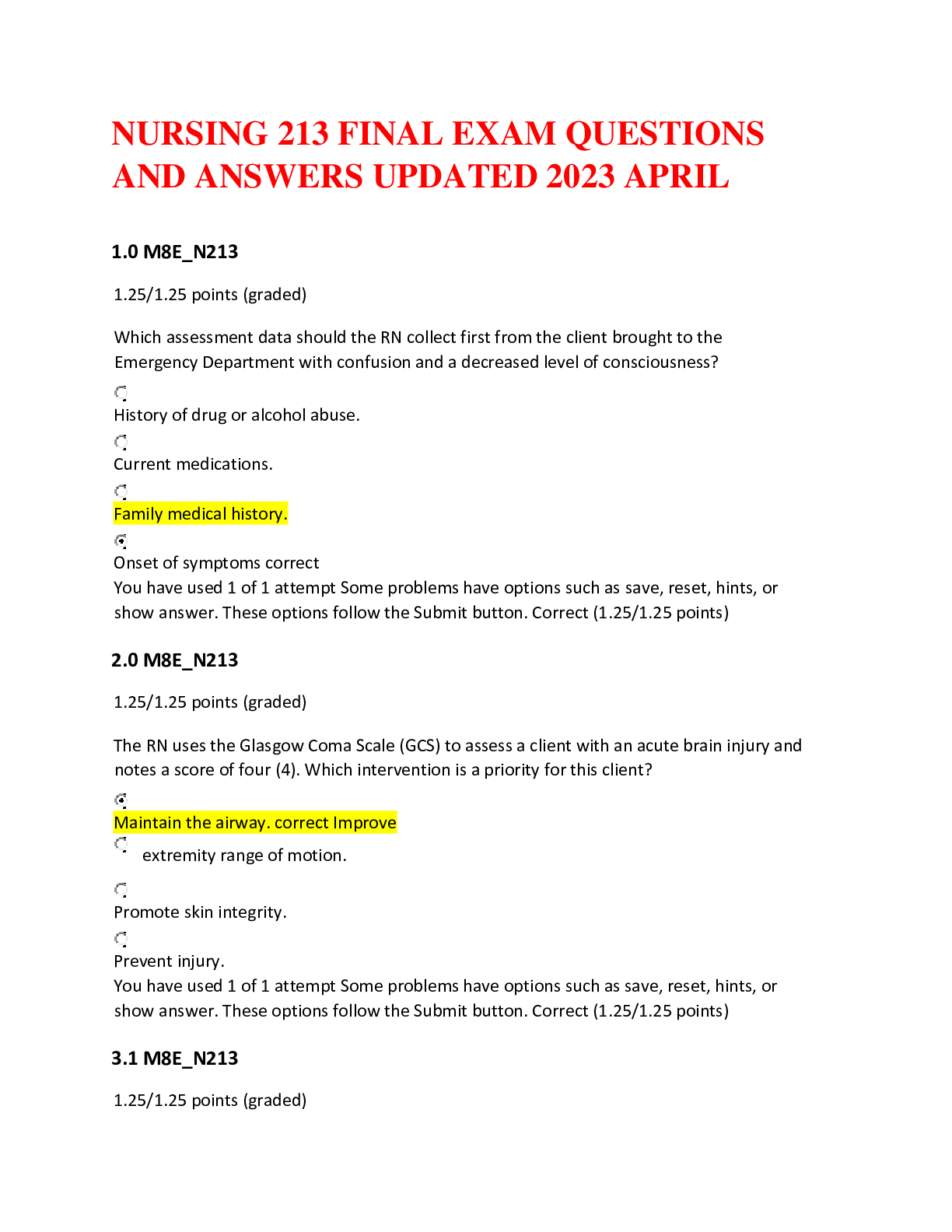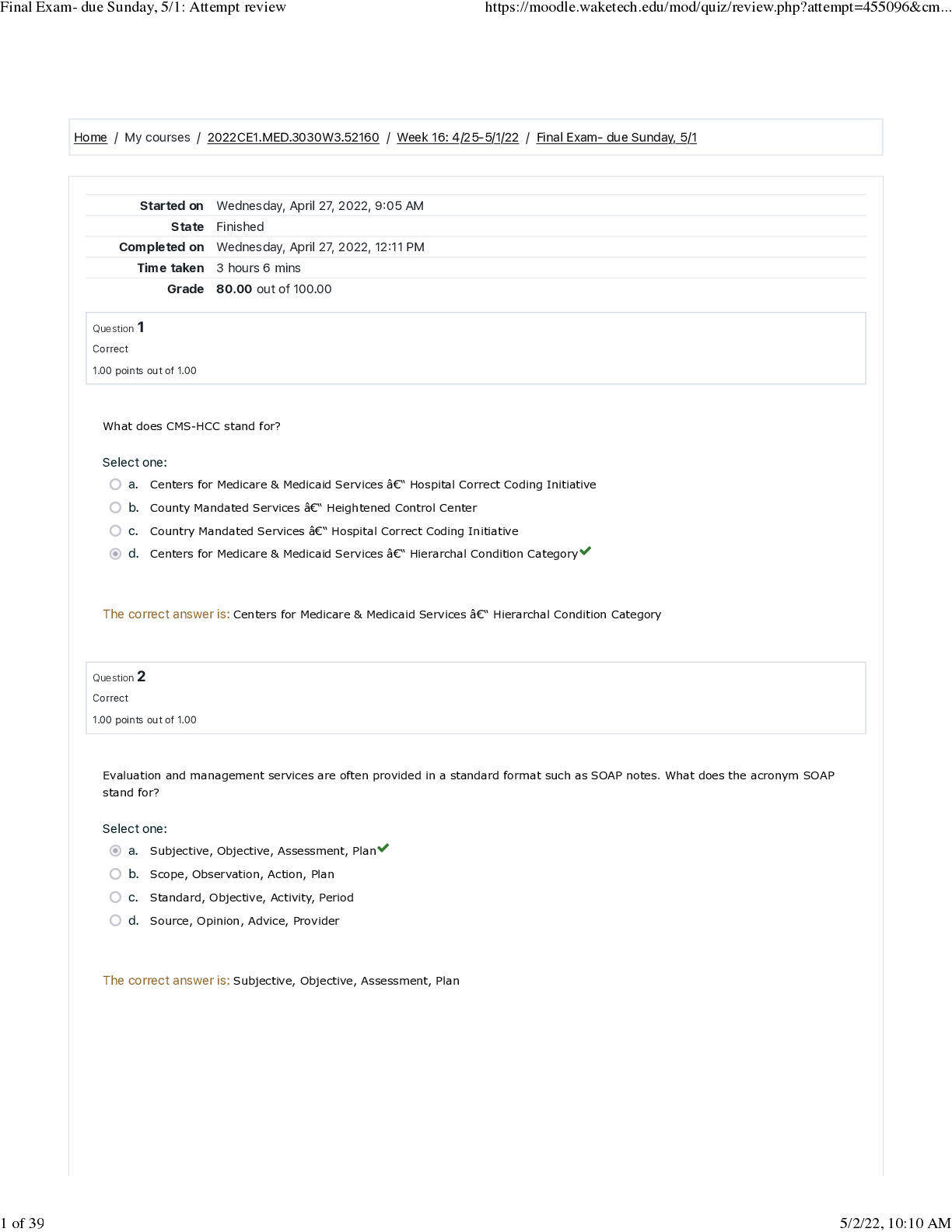*NURSING > EXAM > NSG 6006 Final Exam Question Bank. NSG 6006 Pre-Specialtiy Evaluation - South University Final Exam. (All)
NSG 6006 Final Exam Question Bank. NSG 6006 Pre-Specialtiy Evaluation - South University Final Exam. Contains 80 Q&A Correct Answers Highlighted.
Document Content and Description Below
NSG 6006 EXAM QUESTIONS BANK 1. Once a practice problem has been identified the next step would be to use the PICOT format to ask a question about the problem. PICOT stands for: P—population, I—in... tervention, C—comparisons, O—outcome, T—time. 2. The Affordable Care Act has directed the US Department of Health and Human Services and multiple agencies to develop and disseminate initiatives on meeting the care needs of patients with Multiple Chronic Conditions (MCC). What is the primary purpose for the national direction? To protect against high out-of-pocket costs by prohibiting insurers from denying coverage based on pre-existing conditions. 3. After thoroughly researching the topic of interest, what is the next step an APN should ask in selecting a theory/model for use in practice or research? Have several different theories/models been examined? 4. Which three roles represent the accepted advanced practice nursing roles? Certified Nurse Midwives (CNM) Clinical Nurse Specialist (CNS) Certified Registered Nurse Anesthetists (CRNAs) 5. What are the three major categories of Nola Pender’s Health promotion model? Behavior-specific cognitions and affect Characteristics and experiences Behavioral outcomes 6. Which theorist/s identifies carative factors as a value system, faith-hope and sensitivity to self and others? This describes which of the following theories? Jean Watson theory of human caring 7. Which set of components is essential in a scientific theory? Interrelated concepts, definitions, and propositions 8. The term advanced nursing practice (APN) includes nurses who are: Certified APRNs with a minimum of a master’s degree 9. To meet Medicare’s coverage requirements, the Nurse Practitioner’s services must be: Provided subject to state restrictions and supervision requirements 10. A 20-year-old female comes to the primary care clinic with clinical findings consistent with acute bronchitis. She is sexually active with a male partner, although she states prior to this relationship she did have two sexual partners. Her menses occurs every 28 days and is regular. An example of a primary prevention activity for this patient is: Counseling about safer sexual practices 11. Which agency’s initiative establishes national health promotion and prevention efforts and establishes benchmarks for monitoring the progress of health among Americans over a 10-year timeframe? Centers for Disease Control and Prevention (CDC) 12. Development of the first pediatric nurse practitioner program at the University of Colorado in 1965 is credited to which two individuals? Henry Silver, MD Loretta Ford, MD 13. Raynaud phenomenon is classified as a type III hypersensitivity reaction and is due to: Immune complexes that are deposited in capillary beds, blocking circulation 14. The nurse practitioner is caring for a 21-year-old female who presents with a pruritic, erythematous rash matching pattern of her sandal straps. The nurse practitioner advises the patient to avoid scratching the area due to the risk of developing a secondary infection. The NP understands that the most likely etiology of secondary skins infections is caused by which organism? Staphylococcus aureus 15. How can the APN best influence development and passage of a specific health policy agenda? Determine the best fit between legislative agenda, supporting organizations, and health policy issue. 16. Which is the gold standard research design for generating evidence? Randomized Control Trial 17. The APN is examining a client with new onset HTN. The NP recognizes that HTN may result in significant complications associated with which of the following three organs: Kidneys, Eyes, Brain 18. Which organization allows the use of the “BC” credential? American Nurses Credentialing Center (ANCC) 19. Which agency houses the US Protective and Safety Task Force (USPSTF)? Agency for Health, Research and Quality 20. Which 2 organizations administer nurse practitioner certification programs? American Association of Nurse Practitioners (AANP) American Nurses Credentialing Center (ANCC) 21. Transformational leadership is best defined as: A style that is relational, driven by a common goal, and satisfies the leader and the follower 22. A metaparadigm must include which of the following 3 characteristics? Encompass all phenomena of interest Be perspective—neutral Be global in scope 23. Which statement best reflects King’s theory? If nurses with special knowledge and skills communicate appropriate information to clients, mutual goal-setting and goal attainment will occur 24. Which agency will the APN reference when seeking the current evidence based guidelines directing standards of care? Agency for Health Research and Quality 25. A 43-year old woman has a 12-hour history of sudden onset of right upper quadrant abdominal pain with radiation to the shoulder, fever, and chills. She has had similar, milder episodes in the past. Examination reveals marked tenderness to right upper quadrant abdominal palpation. Her most likely diagnosis is: Acute cholecystitis 26. What theory is used to describe the cause of endometriosis? Endometrial tissue passes through the fallopian tubes and into the peritoneal cavity and remains responsive to hormones. 27. Chronic pain, physical disability, social support, age and gender are related to perceived daily stress, which is related to depression. This is an example of which type of theory? Explanatory 28. The leadership core competency of advanced practice nursing includes which three characteristics? Mentoring, Innovation, Activism 29. What initiative specifically focuses on the aging American, under the Affordable Care Act? Multiple Chronic Conditions 30. Which of the following philosophies of work view would characterize human beings as holistic; parts are viewed only in the context of the whole? Reciprocal Interaction 31. A difficult aspect of determining occupational exposure to disease is the: Long latency period between exposure and disease reporting 32. A novice nurse practitioner is experiencing feeling of inferiority toward more experienced clinicians in the practice. She has identified that time constraints for visits and expectations to increase productivity limits her ability to address these non-adherent issues during client visits. Which barrier to ethical practice is influencing practice? Organizational/Environmental 33. Utilizing Johnson’s Behavioral systems model (JBSM), the APN discovers that a patient is not sure who he can depend on because his wife is emotionally distant. This data would be characteristic of which subsystem of the JBSM. Dependency subsystem 34. A purposeful, complex, dynamic, collaborative, and holistic interpersonal process aimed at supporting and facilitating patients and families through health-related experiences and transitions to achieve health-related goals (mutually determined when possible)” defines which APN role? Coach 35. A 60 year old female with a history of emphysema presents to the primary care office with complaints of cough and shortness of breath at rest. During the physical exam, the nurse practitioner recognizes clubbing, barrel chest, and prolonged expiration. The nurse practitioner understands that the patient is exhibiting symptoms resulting from which type of pulmonary disease process? Obstructive 36. Which of the following statements accurately defines Hamric’s conceptual definition of advanced practice nursing? The patient-focused application of an expanded range of competencies to improve health outcomes for patients and populations within a specialized clinical area of the larger discipline of nursing. 37. When caring for a client who presents with pain and swelling to location of the metacarpophalangeal (MCP) and proximal interphalangeal (PIP) joints. Which diagnostic test is most specific to diagnosis of rheumatoid arthritis? Elevated rheumatoid factor level 38. The Consensus Model for Advanced Practice Registered Nurse Regulations addresses which four areas? Specialty areas Roles and titles to be used Population foci Preparation for emerging APRN roles 39. Which statement best supports primary prevention of burns for geriatric clients? “Avoid smoking in bed” 40. Which of the following three complications are associated with chronic hepatitis B? Continued infectivity Uncompensated cirrhosis Hepatocellular carcinoma 41. The central competency, direct clinical practice, is characterized by which three of the following? Expert clinical performance Formation of a therapeutic partnership with patients Holistic approach 42. Which payment system seeks Medicare reimbursement under the MACRA legislation for providing high quality patient-specific care and improved outcomes? Merit Incentive Based Payment 43. What four components of advanced practice nursing (APN) are specified by the National Council for State Boards of Nursing Consensus Model for APRN regulation? Licensure, Accreditation, Education, Certification 44. Which learning theory would be most applicable as a guide for the development of a program to help families of patients in palliative care? Humanistic Learning Theory 45. What terms indicate appropriate progression associated with the history and evolution of advance practice nursing? Specialist, Expanded Role, Advanced Practice 46. An experienced NP, has two separate but equally important ethical obligations that he is unfortunately unable to carry out. This is an example of which barrier to ethical practice? Moral Dilemma 47. Pre-invasive epithelial tumors of glandular or squamous cell origin describes which of the following? Cancer in situ 48. Which two options are barriers to the conceptualization of Advanced Practice Nursing? Interprofessional education and practice Need to differentiate between advanced practice nursing and medicine 49. The Dreyfus Model of Skill Acquisition includes which four stages of APN performance? Expert, Advanced Beginner, Competent, Proficient 50. The nurse practitioner is caring for a client who has undergone a recent gastrectomy who complains of fatigue, palpitations, shortness of breath, and numbness and tingling to their fingers on both hands. The nurse suspects pernicious anemia related to: Deficiency of intrinsic factor production 51. The analysis of a theory or conceptual model includes examining the origins. Which would not be considered an aspect of origin of the theory/model? The unique focus 52. The clinical manifestations of dyskinetic cerebral palsy include: Jerky uncontrolled and abrupt fine musculoskeletal movements 53. Which core competency incorporates assuming complex collaborative roles with stakeholders and communities? Leadership 54. A critical environmental element that affects the authority of advanced practice nurses to practice to their fullest/maximum scope, according to Hamric’s model, is: Health policy 55. For nursing to considered a discipline, which statement is true? Context has considerable influence on the development of the knowledge base. 56. The APN wants to develop a community educational program for hypertension and stroke prevention. She recognizes that the individual’s lifestyle and pattern of behavior need to be addressed for the program to be successful. Which theory would be most appropriate to guide the program development? Health as Expanding consciousness 57. When considering a theory for use in guiding practice, the APN should examine the Conceptual-Theoretical-Empirical (C-T-E) linkages by for which criteria? Specification adequacy 58. In septic shock, which mediators are anti-inflammatory? Interleukin (IL-4, IL-10, IL13) 59. The link between major depression and cortisol secretion is that individuals with depression: Show that persistently elevated plasma cortisol levels can result in inflammation that is believed to trigger depression. 60. Which three primary criteria for advanced practice nursing are identified in Hamric’s Integrative Model of Advanced Practice Nursing? Guidance, Graduate education, Patient-focused practice, Certification 61. Which advance practice nursing was developed to facilitate delivery of high quality, patient-centered primary care? Certified nurse practitioner (CNP) 62. An adult-gerontology nurse practitioner is employed in a rural practice that is initiating a school-based primary healthcare program. All nurse practitioners in the practice are required to initiate preparations to facilitate conducting patient visits in the new setting. Which role concepts best describes what the adult-gerontology nurse practitioner is experiencing? Role incongruity 63. A MSN student is noting challenges related to attending school while attempting to balance other work, family, and social responsibilities. Which of the following role concepts illustrates the MSN student’s experience? Role stress 64. A 24 year old female presents to the primary care office with complaints of dysuria. Urinalysis lab results indicated positive nitrites. The nurse practitioner plans to initiate antibiotic coverage for the most likely causative organism which is: Escherichia coli 65. Place the following four steps of APN core competency of evidence based practice in order. a. Critically appraise and extract evidence b. Formulate a measurable clinical question c. Review literature for relevant studies d. Implement useful findings in clinical decision making 66. A 12 year old male is diagnosed with Klinefelter syndrome. His karyotype would reveal which of the following? XXY 67. Concerning the MMR vaccine, which of the following is a correct statement? There is no scientific evidence to support MMR use increases autism risk 68. You are seeing a 40 year old patient who has started varenicline (Chantix) 3 weeks ago as a tool for smoking cessation. What is the most important question to ask during the visit? Have you noticed change in your mood? 69. A primary care nurse practitioner (NP) is seeking additional support from ancillary health services for a diabetic client who is noncompliant with nutrition, exercise, and medication. Which barrier to ethical practice is influencing the NP’s practice? Patient-provider 70. Which hospital ownership classification best describes an organization whose excess income is distributed to its shareholders? For profit 71. How has the Quality Chasm Report been used to direct US health care? As a framework for safe, effective, efficient, equitable, timely, and patient centered care. 72. A 12 year old female is newly diagnosed with type 1 DM. When the parents ask what causes this, what is the nurse practitioner’s best response? Immune destruction of the pancreas 73. Which patient below is at most risk for invasive pneumococcal infection? A 32 year old woman who underwent a splenectomy after a motor vehicle accident 74. A Latino patient in your clinic has been perpetually late for his appointment. Which action by the nurse practitioner would be most appropriate? Assess how the patient interprets the appointment time 75. What specific developments have primarily occurred because of the Affordable Care Act (ACA)? Development of patient centered outcomes, use of comparative effectiveness research, quality payment structures that impact APN reimbursement 76. Hamric’s Integrative Model of Advanced Practice Nursing identify the central competency of advance practice nursing that directs the other six core competencies. Direct Clinical Practice 77. A public health nurse is teaching the community about health promotion. When explaining immunity, the APN discusses that innate immunity is: Present at birth 78. According to Madeline Leininger, cultural care/accommodation/negotiation refers to actions/decisions that help a particular culture: Adapt to or negotiate with others for satisfying healthcare outcomes 79. The nurse practitioner is conducting annual physical exam on a 62 year old male. Which of the following risk factors will prompt the nurse practitioner to screen the patient for development of benign prostatic hypertrophy (BPH)? Increased age 80. The family nurse practitioner examines a patient who has sustained a non-work-related injury that interferes with his ability to perform his job. The patient does not qualify for medical disability and has a reasonable chance of engaging in a suitable occupation with proper therapy. What type of services or benefits should the nurse practitioner recommend? Vocational rehabilitation services 1. A 20-year-old female comes to the primary care clinic with clinical findings consistent with acute bronchitis. She is sexually active with a male partner, although she states prior to this relationship she did have two sexual partners. Her menses comes every 28 days and is regular. An example of a primary prevention activity for this patient is: a. Screening for a sexually transmitted disease b. Prescribing therapies to decrease a cough c. Obtaining a Papanicolaou (PAP) test d. Counseling about safer sexual practices 2. A 42-year-old male presents to the clinic with the chief complaint of sinus congestion for 2 weeks associated with facial pain. He is ultimately diagnosed with acute sinusitis, and is prescribed Amoxicillin/clavulanic acid. He has not had a fever, shortness of breath, or any gastrointestinal symptoms. Upon discharge, he is requesting a “flu shot.” You inform him that: a. He needs to return for the shot after he has completed his antibiotic therapy b. Is not an appropriate candidate due to age for the shot c. Is at risk of developing a reaction if the shot is given today d. He can receive the shot in the clinic today 3. Concerning the MMR vaccine, which of the following is a correct statement? a. The link between use of MMR vaccine and autism has been firmly supported b. There is no scientific evidence to support MMR use increases autism risk c. The use of the combination increases autism risk, but dividing them into separate injections minimized this d. The injection contain thimerosal, a mercury agent 4. You are seeing a 40-year-old patient who has started varenicline (Chantix) 3 weeks ago as a tool for smoking cessation. Which of the following is the most important question to ask during this visit? a. “How many cigarettes per day are you currently smoking?” b. “Are you having any difficulty sleeping?” c. “Have you noticed in your mood?” d. “On a scale of 1-10, what is your current desire to stop smoking?” 5. A nurse practitioner is instructing a senior citizen’s group about hazards in the home. One of these is identified as burns. Which of the following would support primary prevention of this hazard? a. Use of a fire extinguisher b. No smoking in bed c. Installation of a smoke detector d. Creating a planned escape route 6. A nurse practitioner is applying for their first position. In researching different hospitals types, there are various descriptions of their type. Some of these include public, proprietary, and voluntary (not-for-profit) hospitals. What qualification would determine the hospital type? a. The degree of reimbursement provided for nurse practitioners b. The determination of whether or not profits are made c. The type of specialty services offered d. How profits are distributed 7. A Latino patient in your clinic has been perpetually late for their appointments. Which action by the nurse practitioner would be most appropriate? a. Confront the patient and advise them the next time you will reschedule c. Assess how the patient interprets the appointment time d. Ignore the situation to avoid having the patient go elsewhere 8. To meet Medicare’s coverage requirements, the Nurse Practitioner’s services must be: a. Provided subject to state restrictions and supervision requirements b. Provided under direct supervision c. Provided in a rural health clinic or federally qualified health center d. Billed through a physician-directed clinic, heath agency or hospital 9. The family nurse practitioner examines a patient who has sustained a non-work-related injury that interferes with the patient’s ability to perform their job. The patient does not qualify for medical disability and has a reasonable chance of engaging in a suitable occupation with proper therapy. The nurse practitioner recommends that the patient apply for: a. Family and Medical Leave Act benefits b. Vocational rehabilitation services c. Home health services d. Social security benefits 10. A difficult aspect of determining occupational exposure to disease is the: a. Confidentiality of the information with company records b. Inaccuracy of occupational exposure c. Long latency period between exposure and disease reporting d. Reliance on worker’s recall 11. In the following patients who is at most risk for invasive pneumococcal infection? a. A 72-year-old man with a history of COPD b. A 32-year-old woman who underwent a splenectomy after a motor vehicle accident c. A 45-year-old man with a 10 year history of type 2 diabetes d. A 80-year-old female with a history of severe osteoporosis and decreased functional status 12. Risks associated with chronic hepatitis B include all the following except: a. Continued infectivity b. Cirrhosis c. Hepatocellular carcinoma d. Malignant hypertension 13. How does health policy specifically influence health care practice in the US? a. Directs efforts by the CDC and protects Americans against population based disease. b. Influences how health care is reimbursed and determines APN payment for services. c. Directs specific evidence based practice guideline development and dissemination d. All of the above 14. What specific developments have primarily occurred because of the Affordable Care Act (ACA)? a. ACA has been appealed and no longer enacted b. Development of patient centered outcomes, use of comparative effectiveness research, quality payment structures that impact APN reimbursement c. Nothing has been changed by the ACA other than Medicaid Expansion and Affordable Health Care d. None of the Above 15. The United States Protective and Safety Task Force determines specific screening requirements for age groups in the US – what agency houses the USPSTF? a. The US Department of Health and Human Services b. Centers for Disease Control and Prevention c. Agency for Health, Research and Quality d. National Clearing House Guidelines 16. The Affordable Care Act has directed the US Department of Health and Human Services and multiple agencies to develop and disseminate initiatives on meeting the care needs of patients with Multiple Chronic Conditions (MCC). What is the primary purpose for this national direction? a. Medicare reimbursement must meet quality payment standards under MACRA legislation b. Advanced Practice Nurses are responsible for addressing the multiple issues associated with this patient population c. Patients with MCCs represent the largest, fastest growing and costliest US patient population d. None of the above 17. As an APN seeking the best evidence to ensure optimal patient-centered outcomes, which agency will you refer to when seeking the current evidence based guidelines directing standard of care? a. Patient Centered Outcomes Research Institute (PCORI) b. Agency for Health Research and Quality c. Centers for Disease Control and Prevention d. US Protective and Safety Task Force 18. When seeking specific epidemiology information on disease statistics and prevention of deadly conditions. What specific agency under the US Department of Health and Human Services would you rely upon? a. National Institutes of Health b. American Cancer Society c. Centers for Disease Control and Prevention d. All of the above 19. Advanced Practice Nurses (APNs) committed to ensuring the safety of an aging society and reducing escalations in mental health disorders will require the following practice to promote wellness in this patient population: a. Certification as a Psychiatry Nurse Practitioner b. Understanding the current health policy directing clinical practice recommendations c. Seek ongoing continuing education credits in mental health and aging d. All of the above 20. Currently, 10,000 Baby Boomers are entering the Medicare system daily. The Affordable Care Act was designed to improve health care delivery through prevention and promotion programs. What initiative specifically focuses on the aging American? a. Team STEPPS b. Multiple Chronic Conditions c. Shared Decision Making d. Literacy Tool Kit 21. How can the APN influence the development and passage of a specific health policy issue? a. Develop a health policy proposal and present it to the House of Representatives? b. Partner with a legislator who is a sponsor of a bill despite his or her specific assigned committee work. c. Determine what the specific legislative agenda is for the nursing organization that you belong – so that your expertise can be used to push the agenda with your specific legislator. d. None of the above 22. How has the Quality Chasm Report been used to direct US health care? a. Is not used to direct health care in the US b. IOM designed this document to direct medical practices in the US c. This report has been used as the framework and foundation for multiple health policy initiatives since its release in 2001 d. None of the above 23. Medicare Access and Summary CHIP Reauthorization Act of 2015, (MACRA) legislation is: a. Bipartisan b. Replaces the 1997 Sustainable Growth Index c. Requires measurement of quality metrics d. All of the Above 24. Team STEPPS training through the Agency for Health, Research and Quality is focused on patient safety. The primary tenets of this training are focused specifically on: a. Interdisciplinary collaboration b. Communication c. Teamwork d. All of the above 25. As an APN providing patient-specific care and seeking Medicare reimbursement under MACRA legislation demonstrating value and quality. You will bill under which payment system? a. Accountable Care Organization b. Advanced Payment Models c. Merit Incentive Based Payment d. All of the above 26. Observational study designs are primarily used in public health data collection and help to determine efficacy of specific interventions. What is an example of a public health concern that is frequently evaluated by the CDC to ensure population-based health and wellness? a. Drug safety and efficacy b. Pasteurization c. Environmental toxins d. Vaccinations 32. For nursing to be considered a discipline which statement is true? a. Defining the knowledge base of nursing is essential and straightforward. b. The discipline of nursing consists of a well-defined knowledge base. c. The human component of the knowledge base of the discipline cannot influence or change the existing knowledge base. d. Context has considerable influence on the development of the knowledge base. 33. Which statements must be present to be considered a metaparadigm? It should (Select all that apply) a. identify a domain that is similar to domains of other disciplines. b. encompass all phenomena of interest c. be perspective –neutral. d. be global in scope. e. Identify all reasonable paradigms 34. A philosophy differs from a metaparadigm because it communicates what the members of a discipline believe to be true about the phenomena of interest to the discipline, what they believe about the development of knowledge and the value assigned to their actions and practices. Which of the following philosophies would be characterized as “human beings are holistic; parts are viewed only in the context of the whole”? a. Reaction World View b. Simultaneous Action World View c. Holistic interaction World View d. Reciprocal Interaction World View 35. Scientific theories should be complex, contain clearly outlines characteristics and have a defined purpose. The components that are essential in a theory is the set of: ? a. interrelated concepts, definitions and propositions. b. interrelated statements which assume all the relationships to be true. c. statements that are based on the author’s opinions and experience only. d. propositions and constructs that are not necessarily tied together. 36. Theory attributes meaning, provides explanation, imposes order and organizes logically the events that that healthcare professionals come into contact with. Which is an example of the steps that practitioners take in theorizing? a. Ask certain questions, research the topic, implement what is developed, evaluate the implementation b. Ask certain questions, Question the status Quo, Seek the most plausible answer, Build a narrative for the questions and answers c. Question the status quo, Seek a meaningful answer, Build a program to answer the question and evaluate the program d. Question the status quo, seek a meaningful answer, build a logical structure for the questions and answers, Review other theories about the situation 37. Which of the following statements best addresses how theory can guide and direct practice? a. Nursing theories will guide the way of relating with the person, and direct the goals of practice with the person. b. Research studies are the associated methods, procedures and empirical indicators that guide practice. c. Nursing theory is essential to the continuing evolution of the discipline of nursing. d. Nursing theories are required when an organization is applying for magnet status. 38. To implement a theory/conceptual model into practice, the nurse would identify the purpose of the practice, general nature of the practice problem, the setting of the practice, and the characteristics of participants in the practice. What would be the next step for the nurse? a. Decide on the timeframe for implementing the theory/ model. b. Enlist nursing staff and physicians in the practice who would be involved. c. Determine the process and technology used as well as assessment and evaluation of outcomes. d. Review several models to decide on the best approach for the practice. 39. Which theorist identifies carative factors as a value system, and faith-hope and sensitivity to self and others? a. Dorothea Orem b. Paterson’s and Zderad c. Jean Watson d. Margaret Newman 40. Which statement below best reflects Imogene King’s theory? a. The coping process responses constitute the outputs of the human??? adaptive system. b. A person is a system of behavior characterized by repetitive, predictable, and goal –directed behaviors that strive toward balance. c. Nursing goals are negotiated with the client and take into account both the client’s and the nurse’s perceptions. d. If nurses with special knowledge and skills communicate appropriate information to clients, mutual goal-setting and goal attainment will occur. 41. The APN wants to develop a community educational program for hypertension and stroke prevention. She recognizes that the individual’s lifestyle and pattern of behavior need to be addressed for the program to be successful. Which theory would be most appropriate to guide the program development? a. Theory of health as expanding consciousness. b. Theory of Human Caring. c. Theory of culture care. d. Theory of interpersonal nursing. 42. According to Madeline Leininger, cultural care/accomodation/negotiation refers to actions or decisions that help a particular culture: a. retain and preserve care values b. adapt to or negotiate with others for satisfying healthcare outcomes. c. change or modify behaviors affecting their lifestyles. d. work with each other to set up goals for improved health outcomes. 43. What are the three major categories of Nola Pender’s Health promotion model? (Select all that apply) a. *Individual characteristics/ experience b. *health outcome c. Individual health measures; d. *behavior –specific cognitions e. measureable health outcomes 44. The APN wants to evaluate the effectiveness of a protocol change that has lessened the waiting time for patients with acute symptoms of an exacerbation of COPD to be seen in a primary care practice. He is interested in whether the change reflects an improvement in prevention of hospitalization for COPD as well as the patient’s quality of life. What does he need to consider if he wants to utilize the Health-related quality of life (HRQOL) theory to guide his evaluation? a. There are multiple frameworks and models to choose from b. Only biological and physiological variables and symptoms are included c. An individual’s perceptions are not addressed in the theory d. Quality of life and HRQOL are interchangeable concepts 45. Which learning theory would be most applicable as a guide for the development of an educational program for families of patients in palliative care? a. Behaviorist Learning Theory b. Cognitive Learning Theory c. Psychodynamic Learning theory d. Humanistic Learning theory 46. To analyze and evaluate a theory/ model for potential use in guiding practice, the APN should consider what internal factors? (Select all that apply) a. Clarity b. Consistency c. Logical development d. Adequacy e. Level of theory development 47. The analysis of a theory or conceptual model includes examining the origins. Which would not be considered an aspect of origin of the theory/model? a. The historical evolution of the theory/ cmodel b. The motivation to develop the theory/model c. The unique focus of the theory/model d. The philosophical beliefs and values about the theory/ model 48. After thoroughly researching the topic of interest, what is the next step an APN should take in selecting a theory/ model for use in practice or research? a. Decide if the theory/model fits with the purpose/ topic of interest. b. Examine major concepts of the theory/model to determine how they relate to each other. c. Consider several different theories / models for possible use. d. Decide if the assumptions, rationale and suppositions in the theory/model can be accepted by the APN. 49. Fawcett’s Conceptual-Theoretical-Empirical Structure (CTE) involve what linkage? a. Parsimony b. Testability c. Adequacy d. Legitimacy 50. Once a practice problem / research question has been identified the next step would be to use the PPICOT format to define the question. PICOT means: a. P --population, I-- intervention, C-- Concepts, O--operational definitions, T –Time b. P—precision instrument, I—intervention, C—control, O—operational definitions, T—Time c. P—population, I – internal validity, C –Comparisons, O –outcome, T – time d. P—population, I – intervention, C – comparisons, O – outcome, T – time 51. The APN is using Johnson’s Behavioral systems model (JBSM) to guide the assessment process for a patient who is being treated for lung cancer and presents to the emergency department with fever and neutropenia. Some of the assessment included that the patient realized his ability to care for himself and his family is decreasing as his health worsens. He is not sure who he can depend on because his wife is emotionally distant. This data would be characteristic of which subsystem of the JBSM? a. Restorative subsystem b. Aggressive protective subsystem c. Dependency subsystem d. Affiliative protective subsystem NSG6006 Study Guide 5000 (Roles) • History and Developmental Aspects of Advanced Practice Nursing • Definition of advanced practice nurse (APN) • History of APN movement • Evolution of the APN role • Four recognized APN roles o Clinical nurse specialist o Nurse practitioner (primary care; acute care) o Certified nurse midwife o Certified registered nurse anesthetist • Essentials of masters and doctoral education for APNs • Core competencies of practice • Practice environments, regulation, reimbursement • Scope of practice • Development of the APN role-novice to expert theory (add theories and models) • Dreyfus model: Novice to Expert Skill Acquisition Model • Role Concepts: • Role ambiguity • Role incongruity • Role conflict • Interprofessional role conflict • Role transition • Role stress • Role implementation • Mentoring • Conceptual models for APNs • Conceptualization barriers • Hamric’s Integrative Model • Fenton and Brykczynski’s Expert Practice Domains • Calkin’s Model of Advanced Practice Nursing • Brown’s Framework for Advanced Practice Nursing • Oberle and Allen • Shuler Model of Nurse Practitioner Practice • Ball and Cox Theory • Practice Models for APNs • AACN Synergy Model • Dunphy and Winland-Brown Circle of Caring • Advanced Practice Professional Organizational Perspectives • APRN Consensus Model for regulation: Licensure, Accreditation, Certification, Education (LACE) • American Nurses Association • American Association of Colleges of Nursing • National Organization of Nurse Practitioner Faculties • National Association of Clinical Nurse Specialists • American Association of Nurse Anesthetists • American College of Nurse-Midwives • International Organizations • Practice settings, population foci, scope of practice for each APRN role • New innovative roles – educator, administrator, informatics • Competencies of Advanced Practice Nursing o Ethical principles related to practice and decision making o Direct clinical practice o Coach Definition o Leadership o Definition o Characteristics o Leadership theories (list these) o Leadership styles (list these) o Implementation strategies o Change theory • Evidence-based practice (EBP) • Levels of evidence • Steps of APN core competency EBP • Appraisal of evidence • Integrating EBP • Randomized Control Trial • Collaboration • APN advocate role • Advanced Practice Roles and Operations o Recognized APRN roles o Clinical nurse specialist o Nurse practitioner (primary care; acute care) o Certified nurse midwife o Certified registered nurse anesthetist • Scope and standards of practice • Leadership development plan for practice • Key Components of Managing Advanced Practice Environments o Certification requirements for each role o Certifying organizations o Regulatory and legal requirements o Credentialing, privileging, and prescriptive Authority o Health policy o Consulting relationships o Business practices o Marketing and negotiation o Practice culture and team building 5002 (Theory) • Foundations • History and evolution of nursing science • Knowledge development • Structure and function of theory • Relationship of Theory to practice and research • Middle range theories • Jean Watson theory of human caring • Imogene King Conceptual system • Theory of Goal Attainment • Grand theories Newman’s theory of health • Leininger’s theory of culture care • Conceptual models • Nola Pender’s Health Promotion Model • Non-nursing theories • Health Related-Quality of life • Humanistic Learning Theory • Behaviorist Learning Theory • Cognitive Learning Theory • Conceptual-Theoretical-Empirical • Application to Nursing practice • Theory analysis and evaluation • Selecting a theory • PICOT acronym • Johnson’s Behavioral Systems Model 5003 (Pathophysiology) • Physiology and pathophysiology across the life span • Geriatric • Adult • Pediatric • Genetics/Genomics • Normal Physiology vs. Pathologic Changes in Common Health Alterations • Cellular response • Physiologic and Psychological Response to Illness • Etiology, Pathogenesis, and Clinical Manifestations of Common Alterations in Health • Integumentary • Neurologic • Cardiovascular • Respiratory • Immunologic/Infectious • Gastrointestinal • Genitourinary • Psychiatric • Musculoskeletal • Endocrine • Hematological • Reproductive • Cancer 6002 (Health Policy and Health Promotion) • Health Promotion and Population-based Health Policy • Legislative and public policy • Multidisciplinary/Interprofessional Collaboration • Advocating for population focused policies • Determinants of Health • Environmental • Global • Social • Epidemiology • Population Focused Health Promotion and Maintenance: Clinical Intervention • Community needs assessment • Physiologic • Psychosocial • Anticipatory guidance • Counseling for health behavior modification • Primary, secondary, tertiary prevention • Developing prevention focused interventions • Ordering and interpreting screenings • Vaccinations • Population Focused Health Promotion and Maintenance: Program Development • Advocacy • Implementation • Monitoring • Evaluating effectiveness • Incorporating Theory and Research • Hospital classifications • Cultural diversity • Medicare requirements • Vocational Rehab • CDC • ARHQ • United States Protective and Safety Task Force (USPSTF) • The Affordable Care Act [Show More]
Last updated: 9 months ago
Preview 1 out of 36 pages
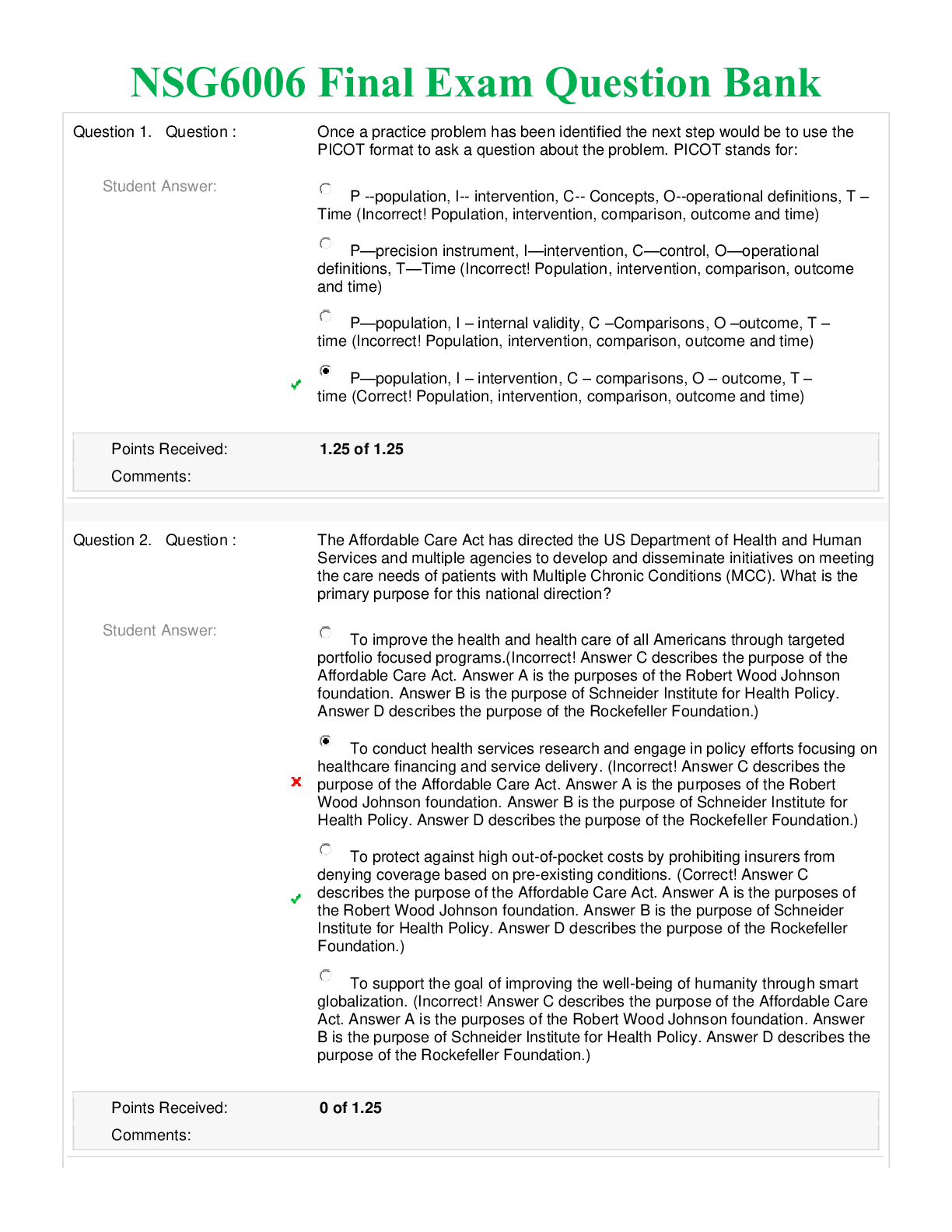
Reviews( 3 )
Document information
Connected school, study & course
About the document
Uploaded On
May 03, 2020
Number of pages
36
Written in
Additional information
This document has been written for:
Uploaded
May 03, 2020
Downloads
4
Views
377


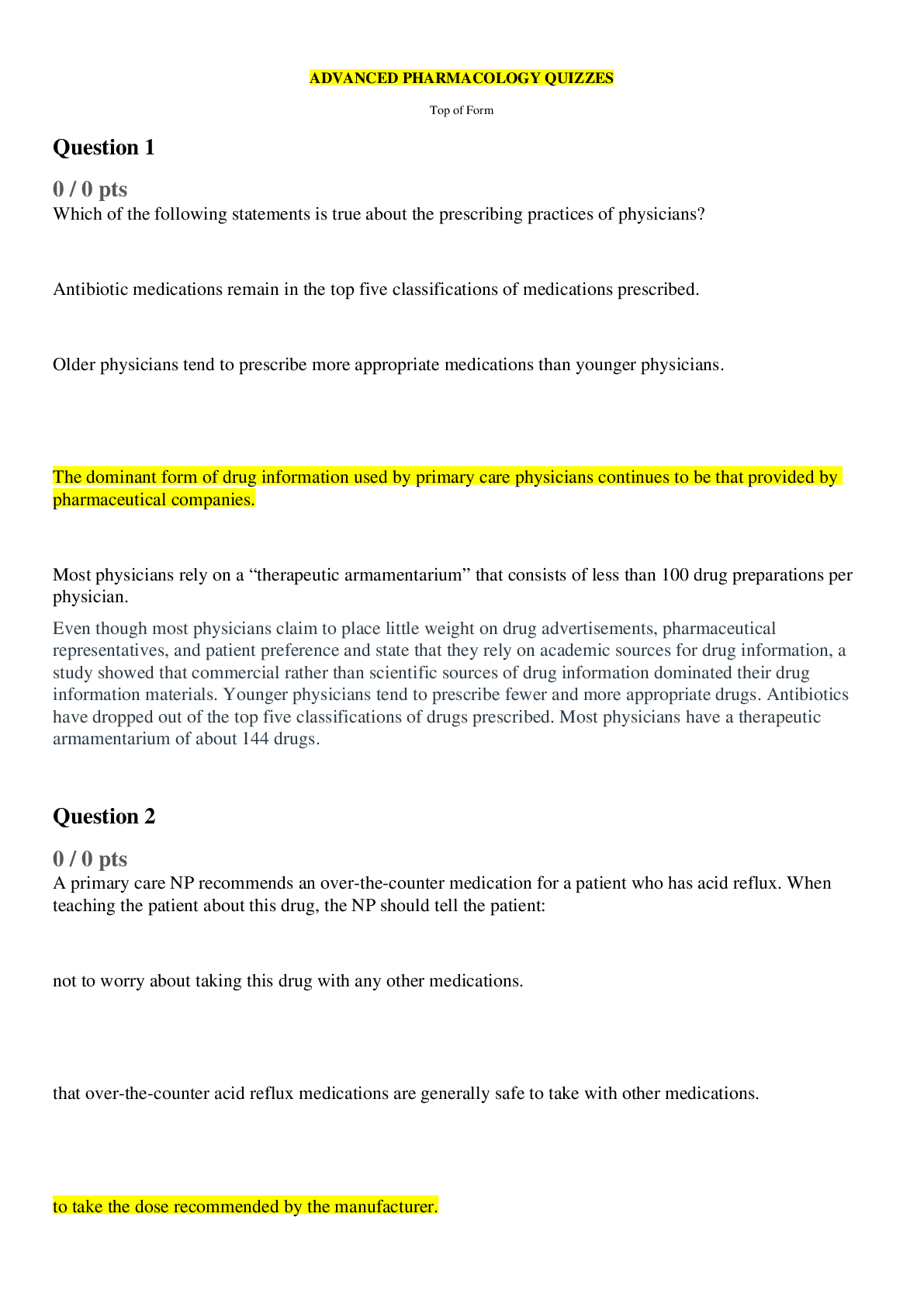
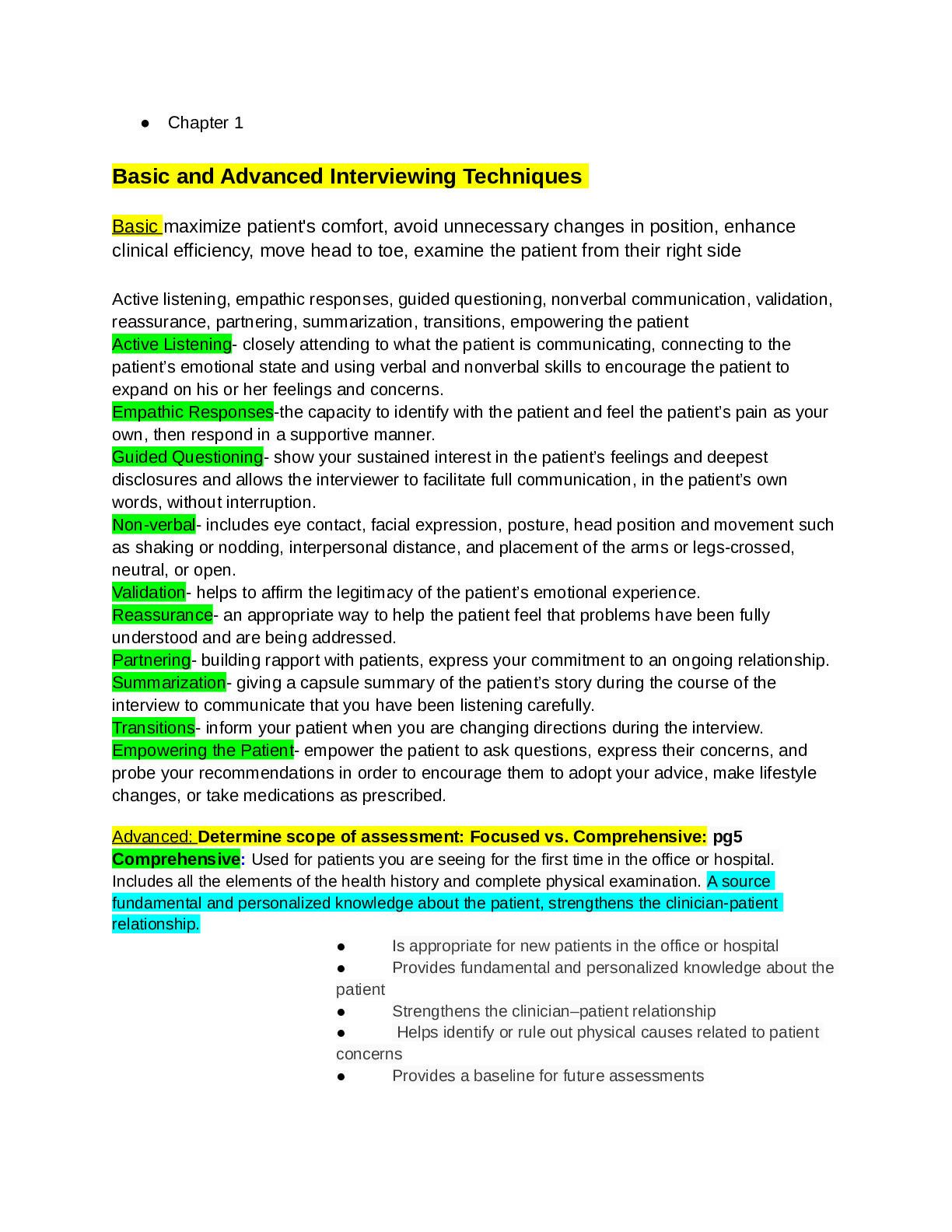
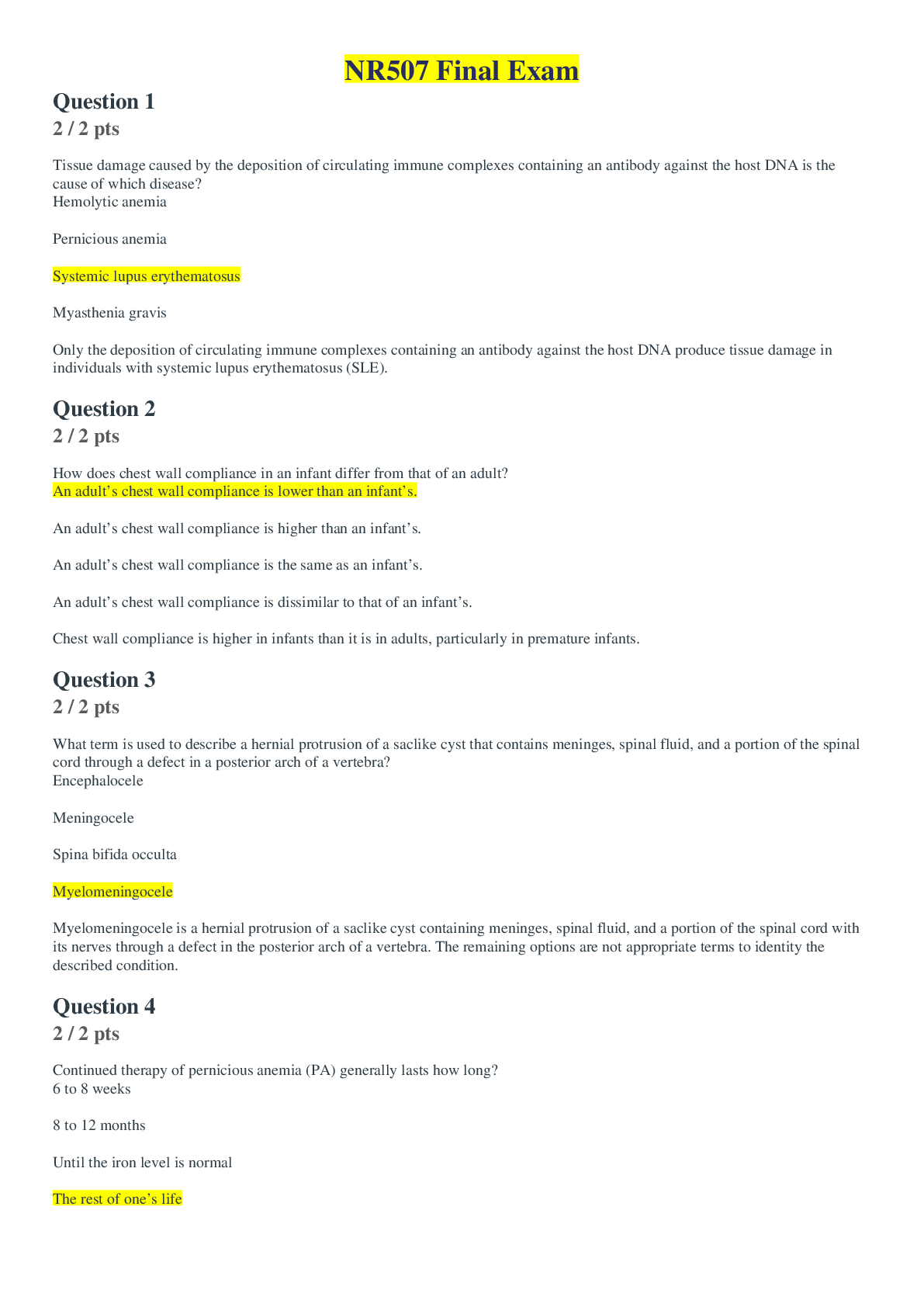
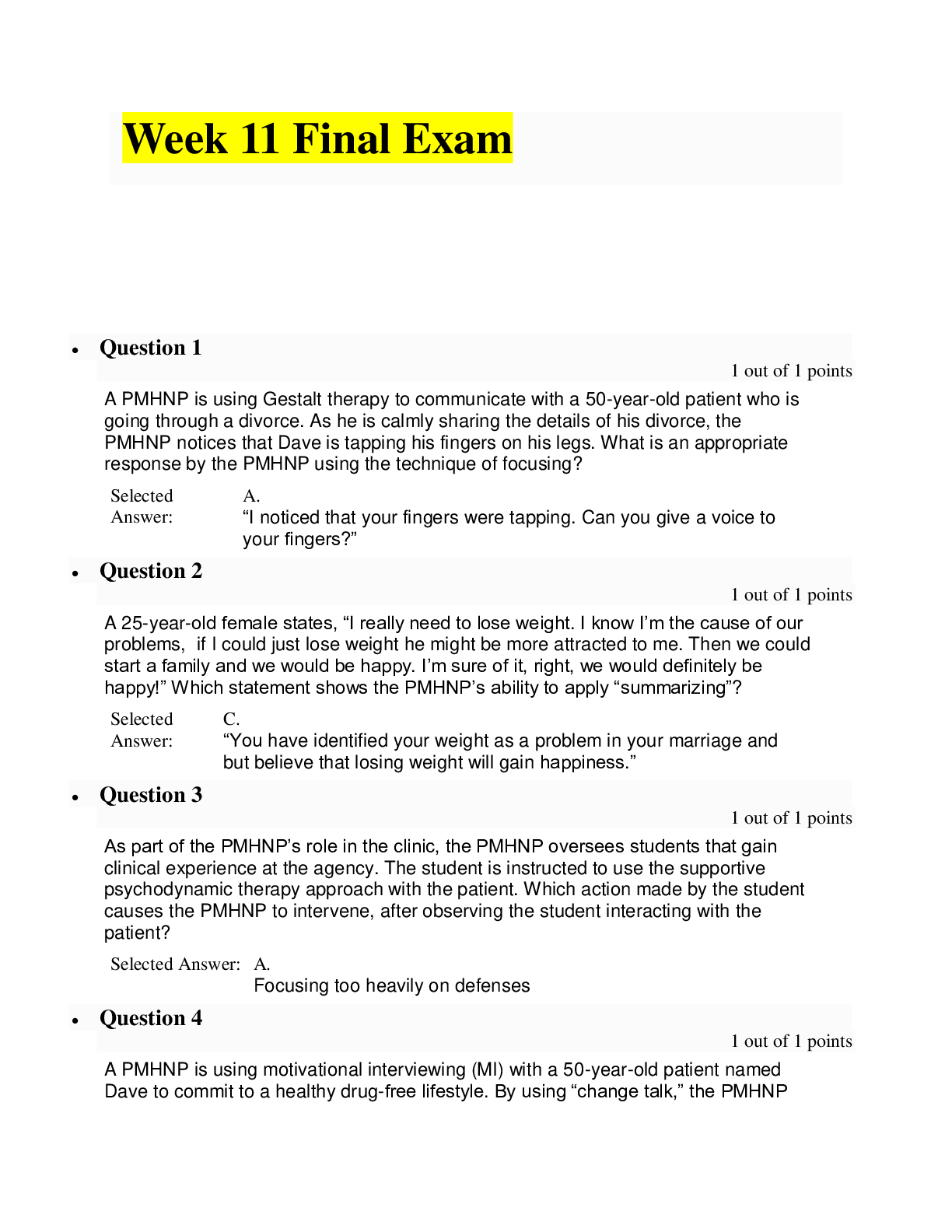
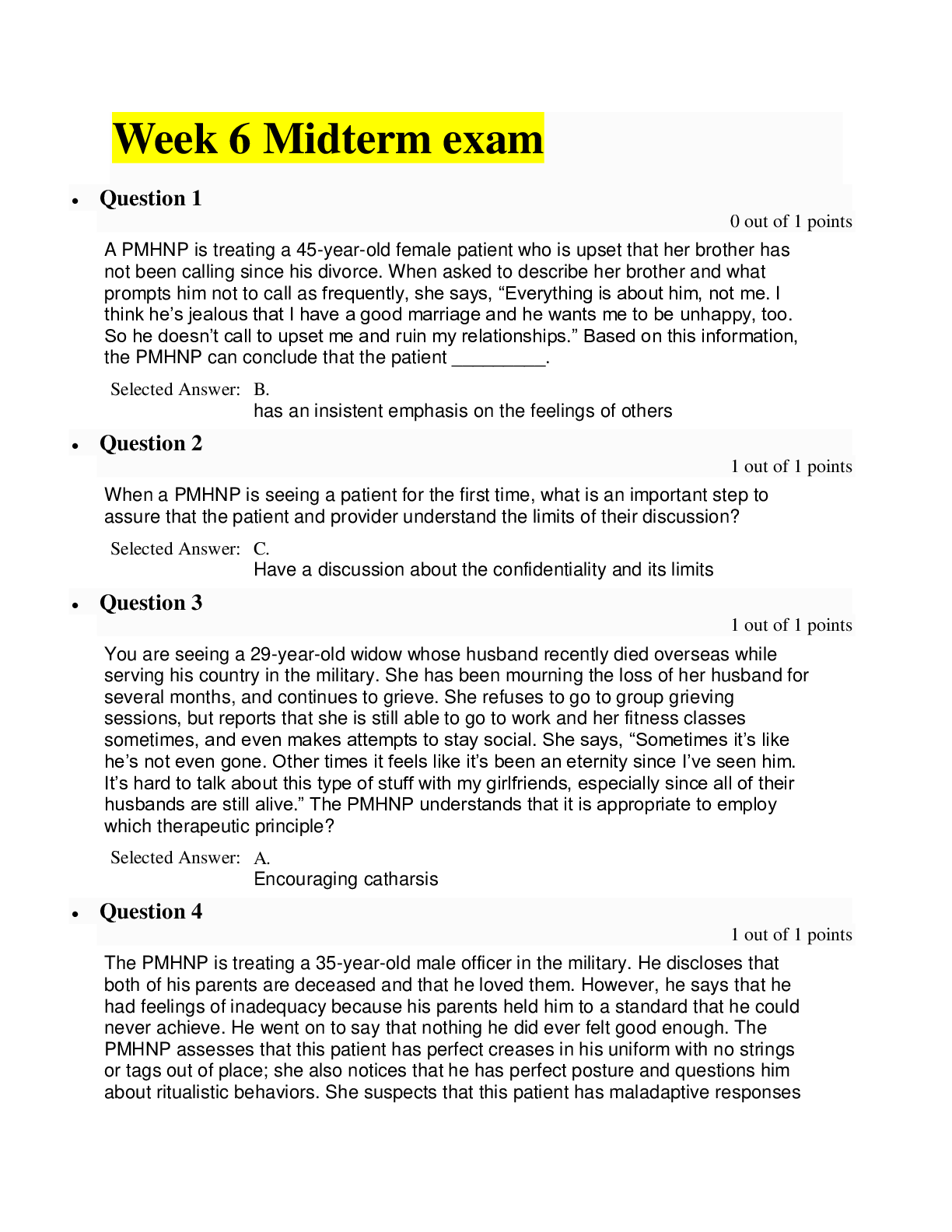
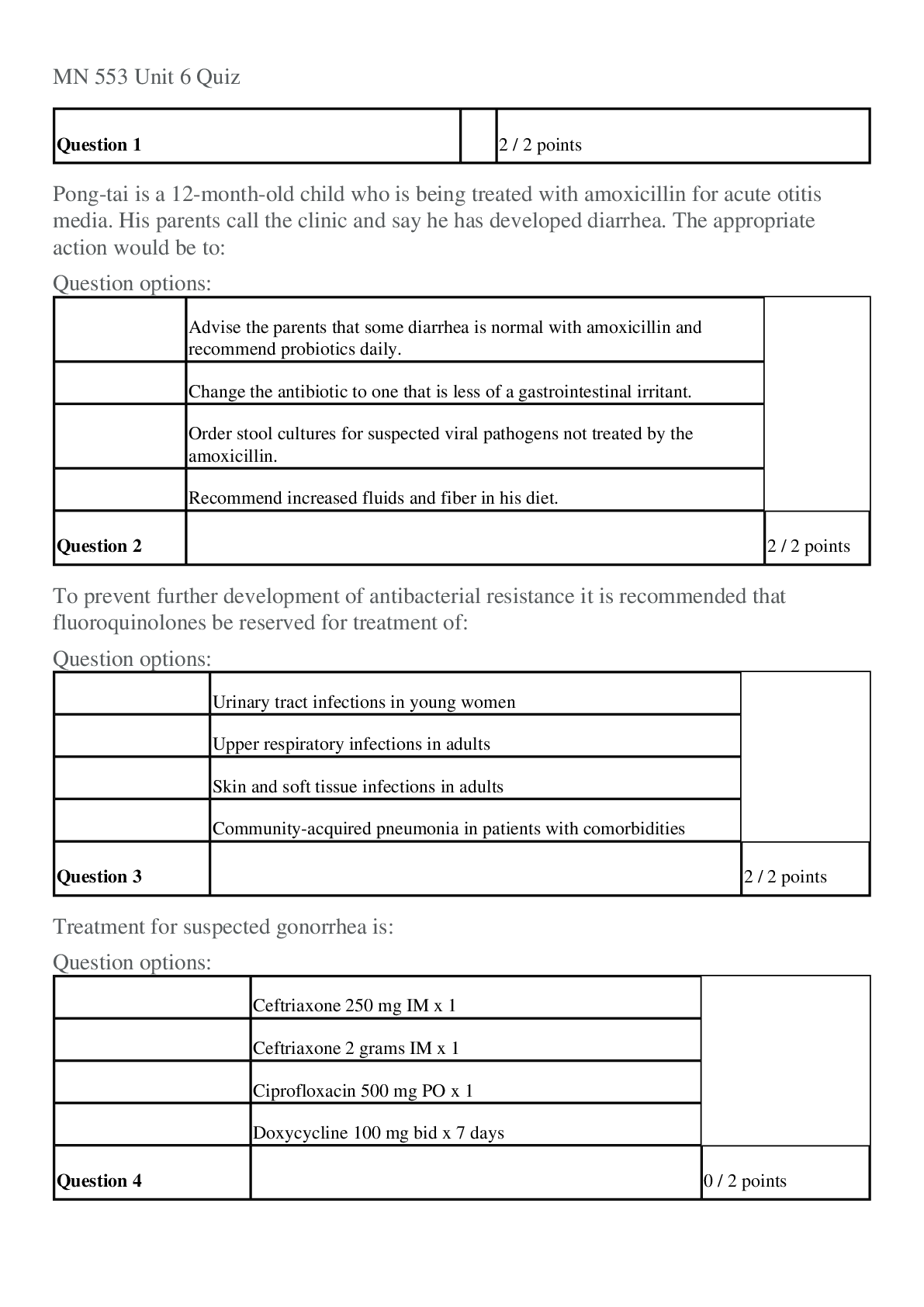
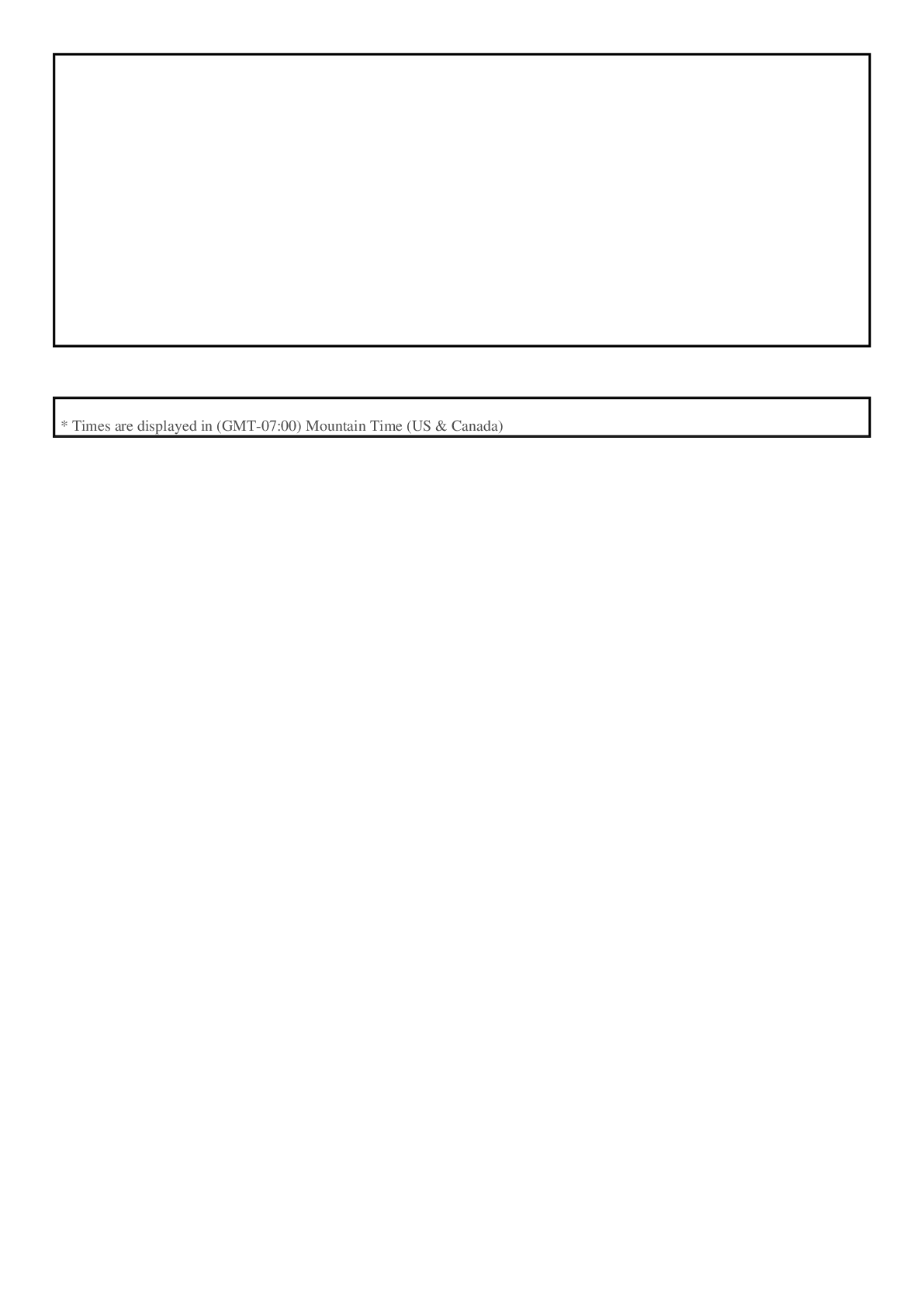

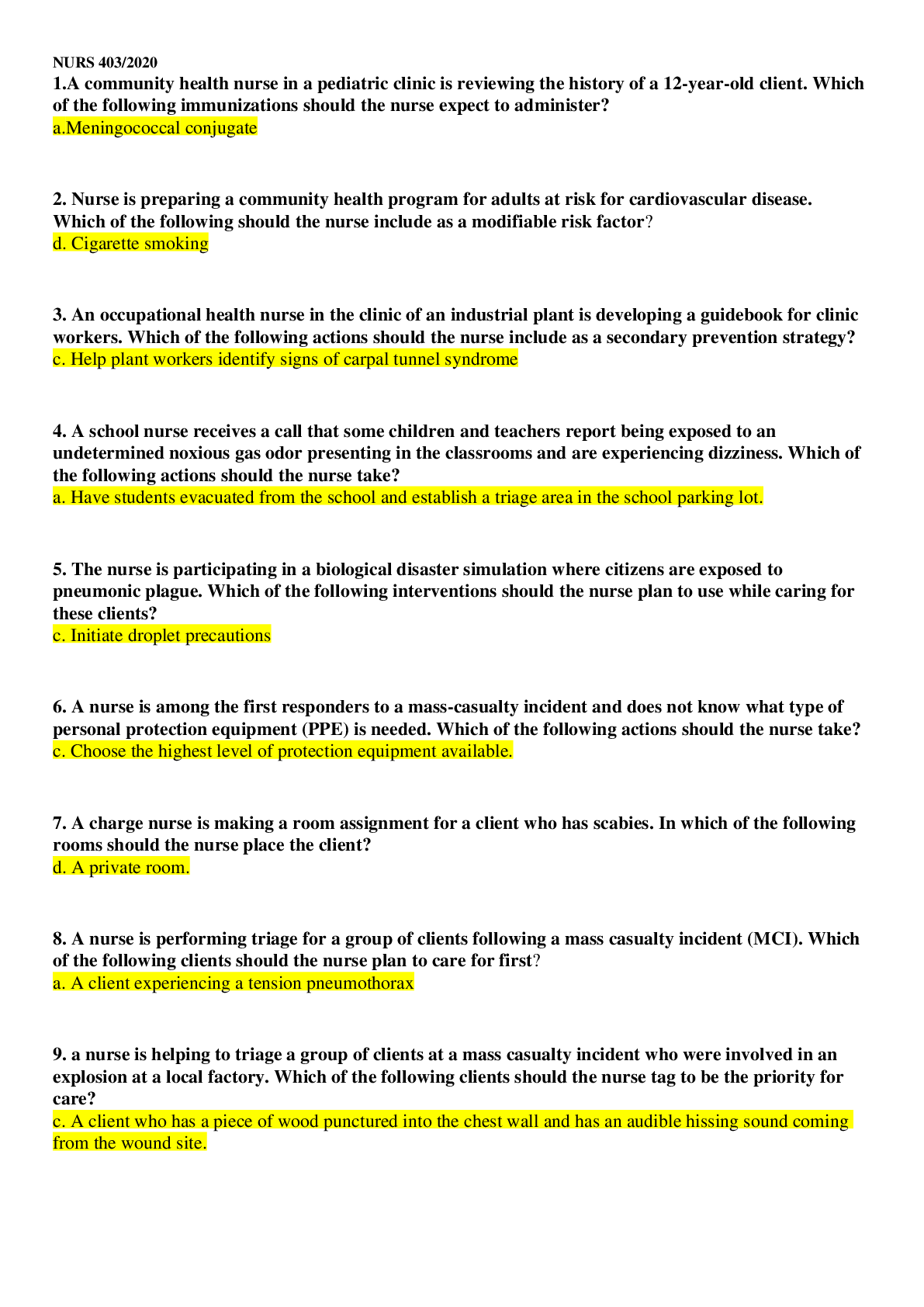
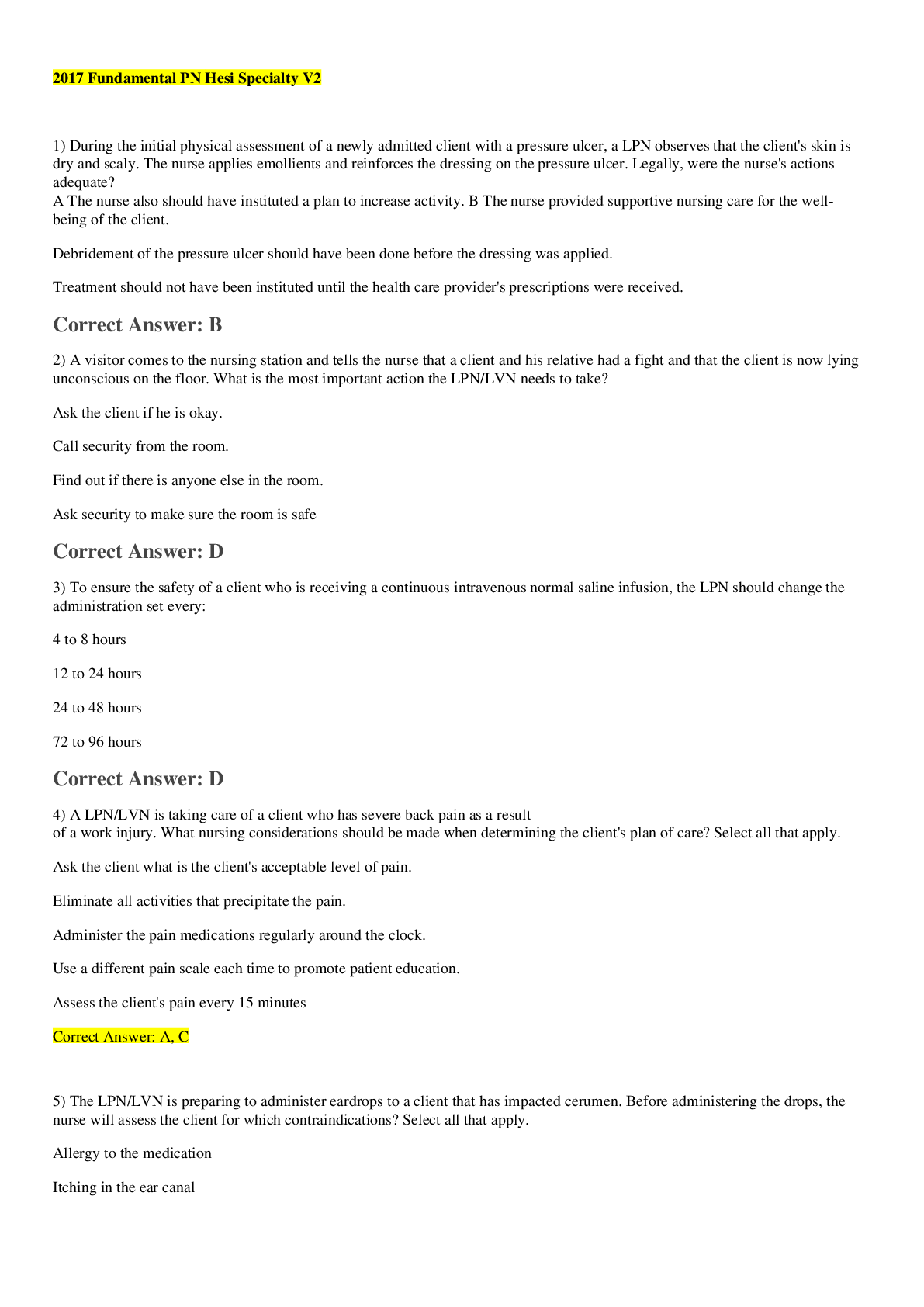
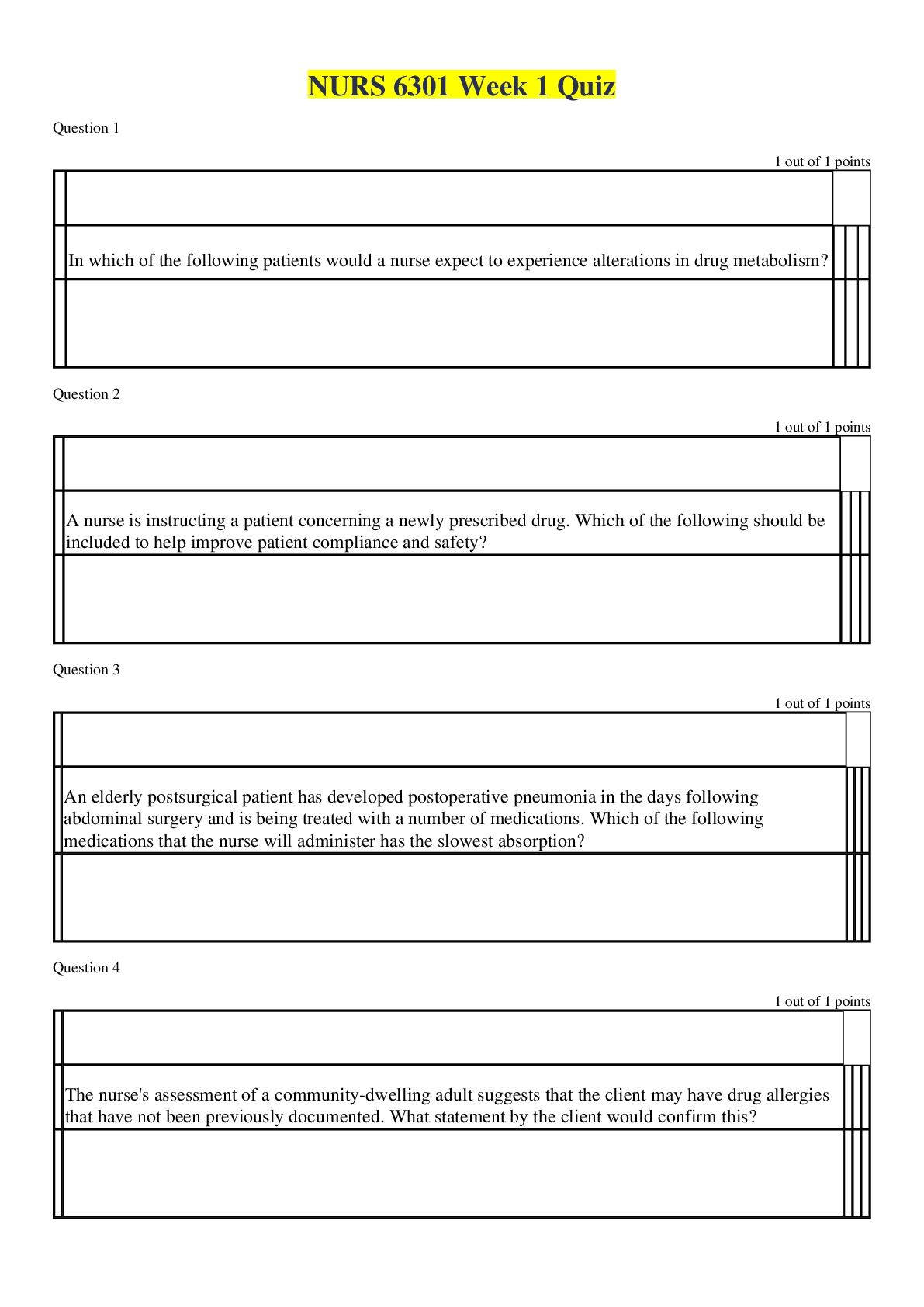
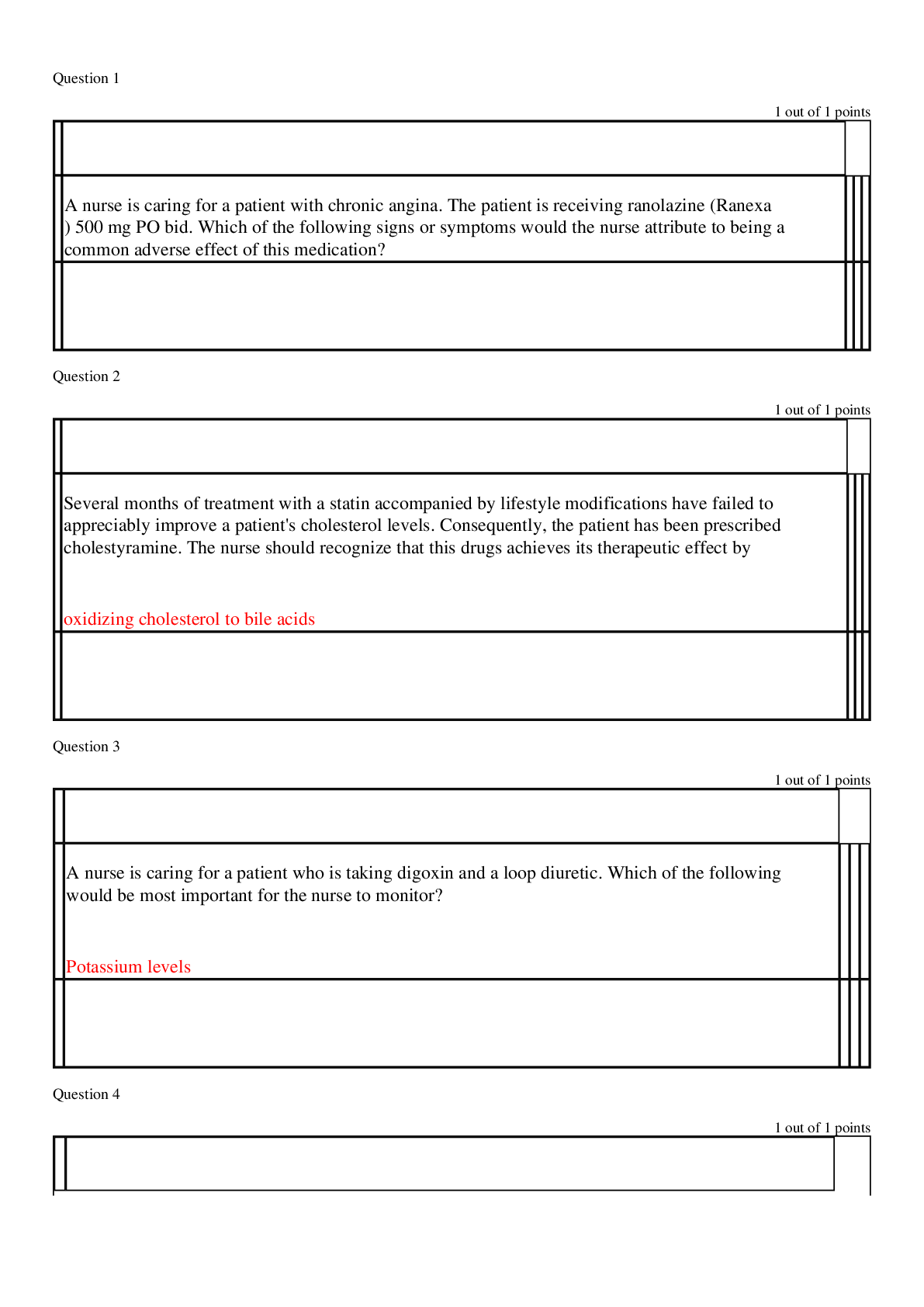
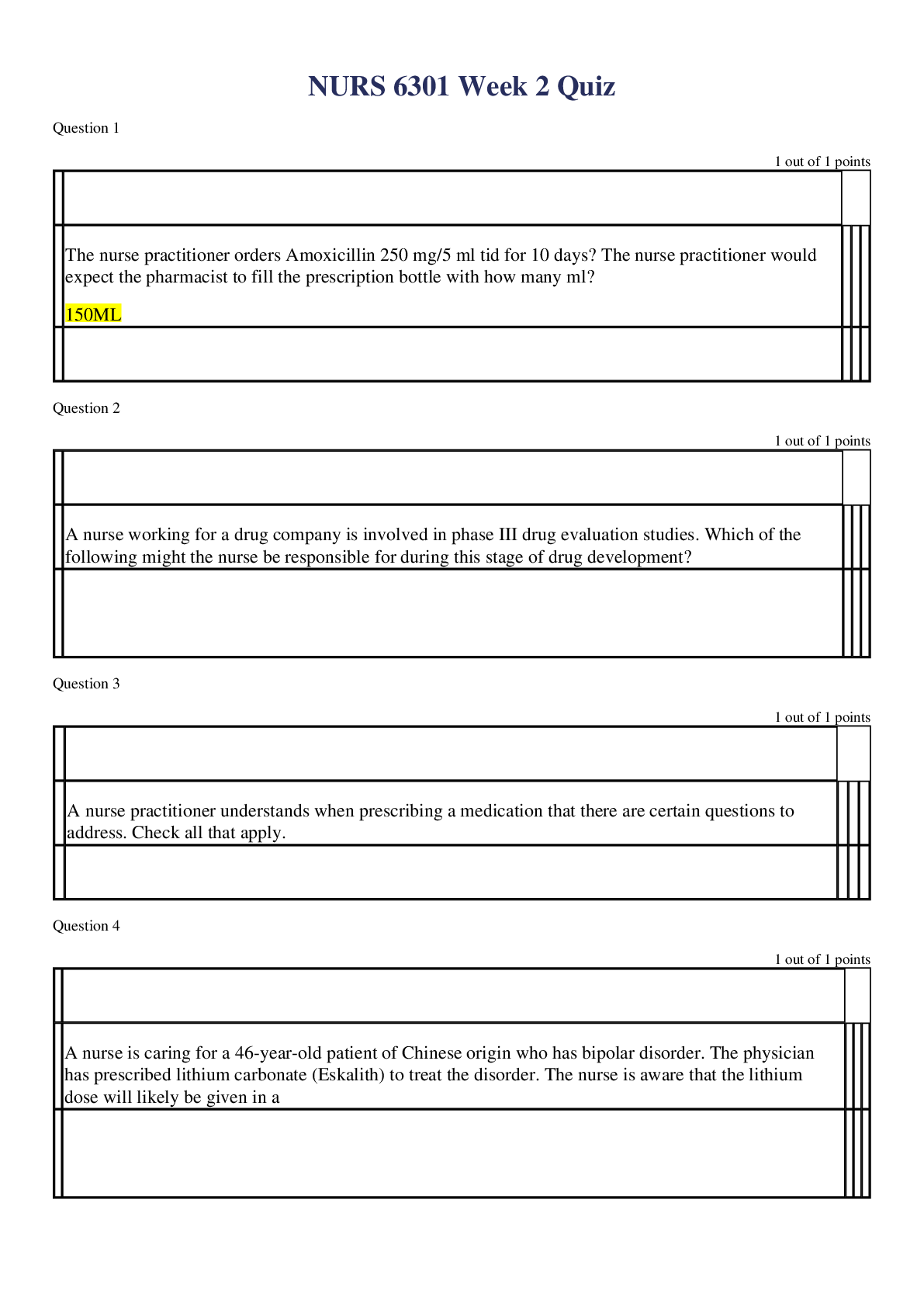
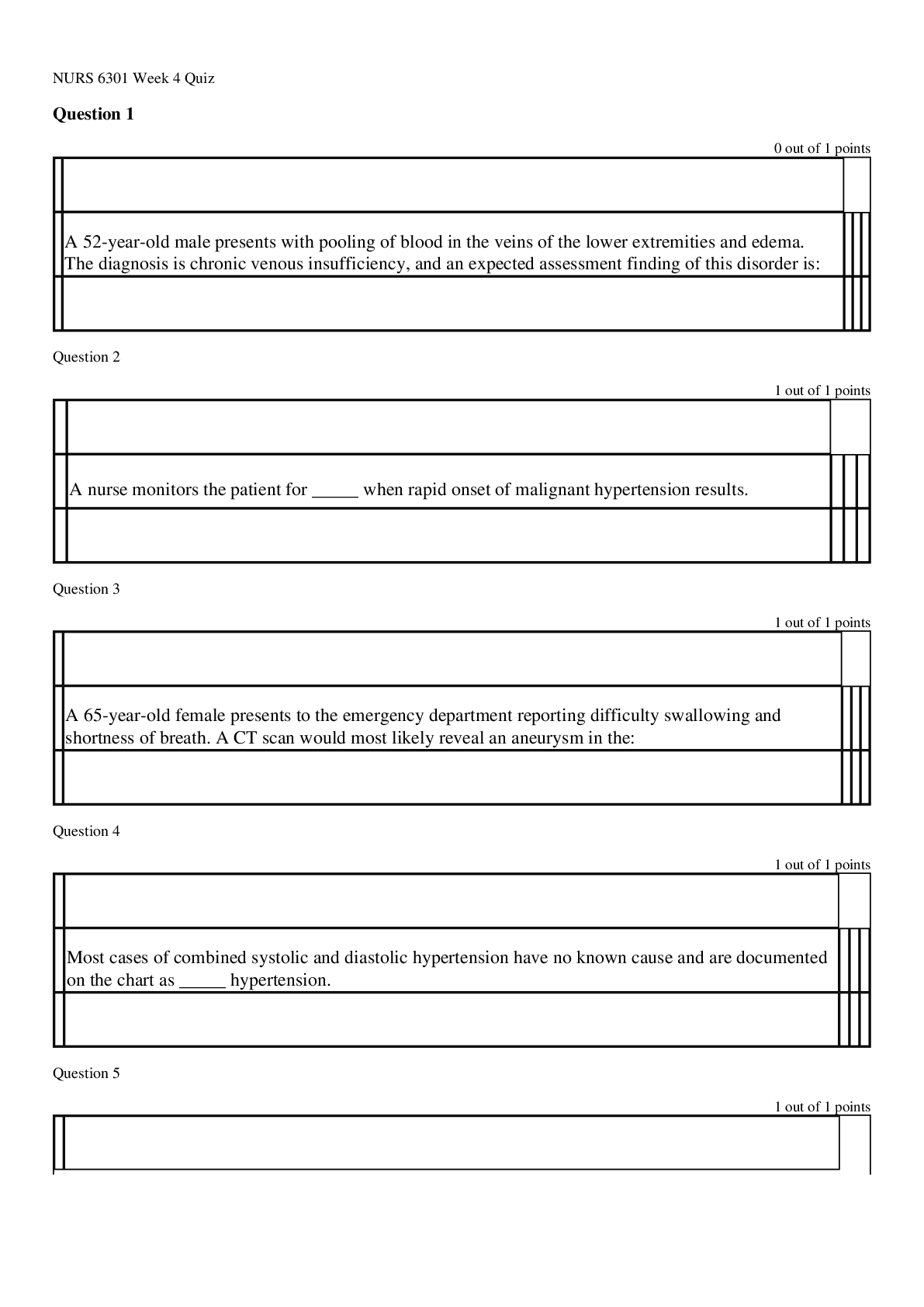
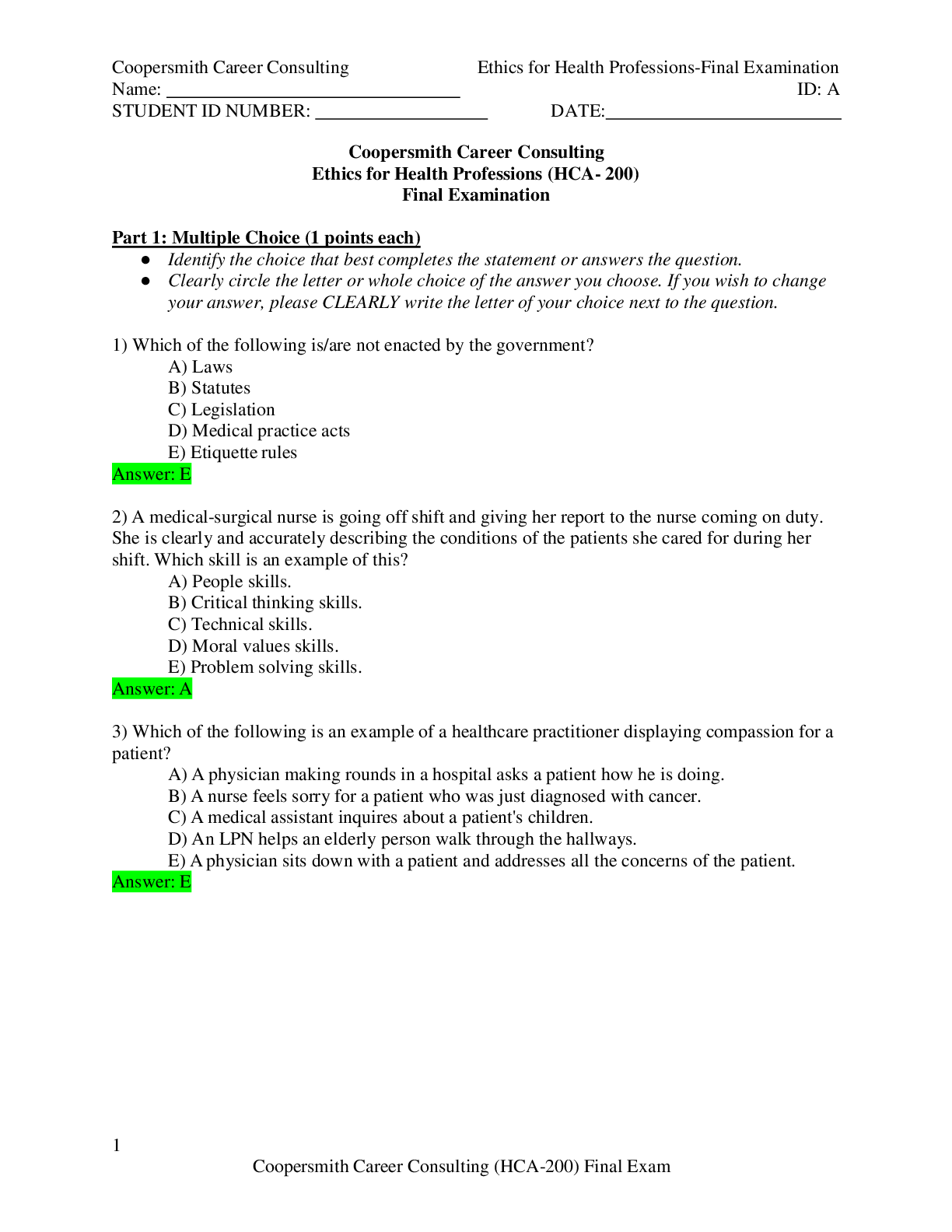
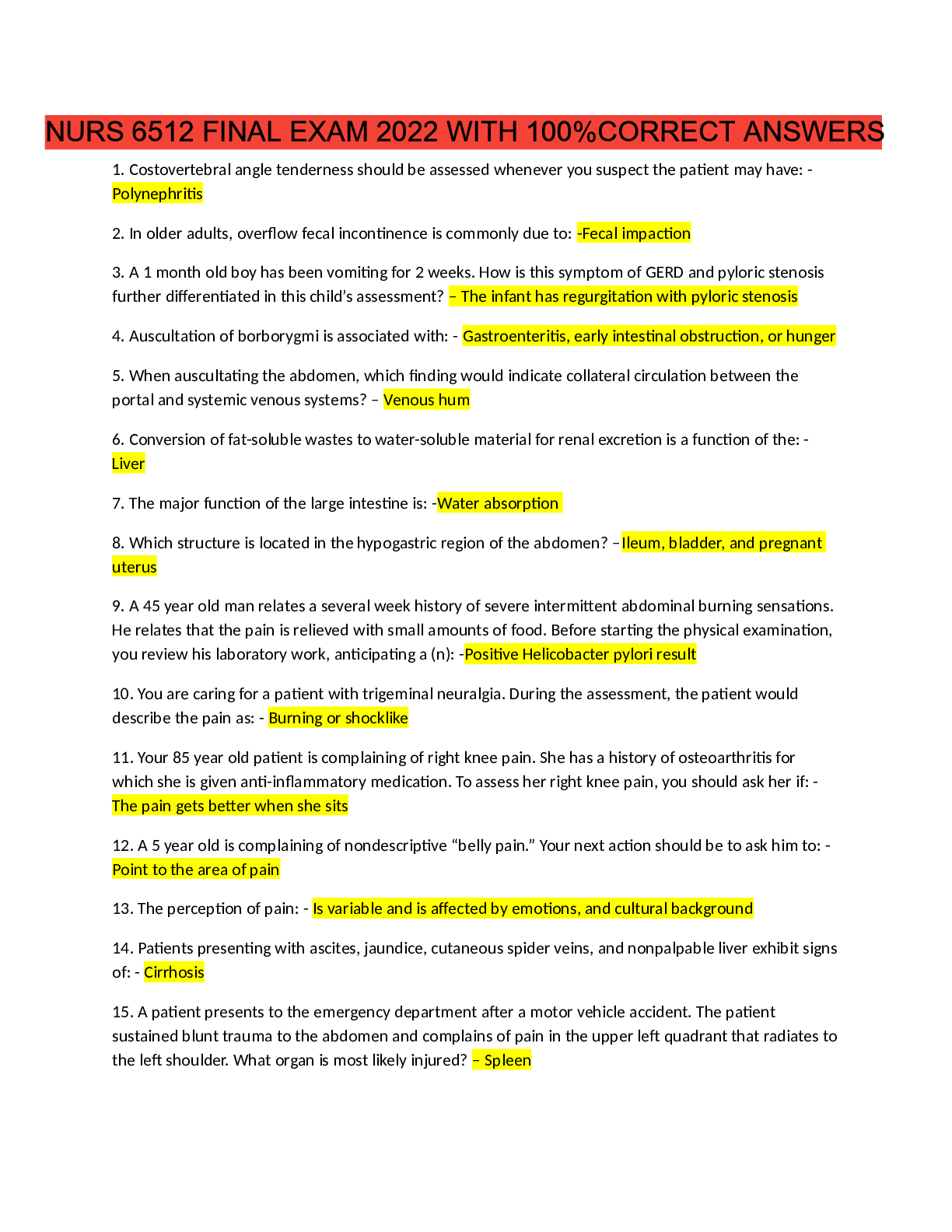
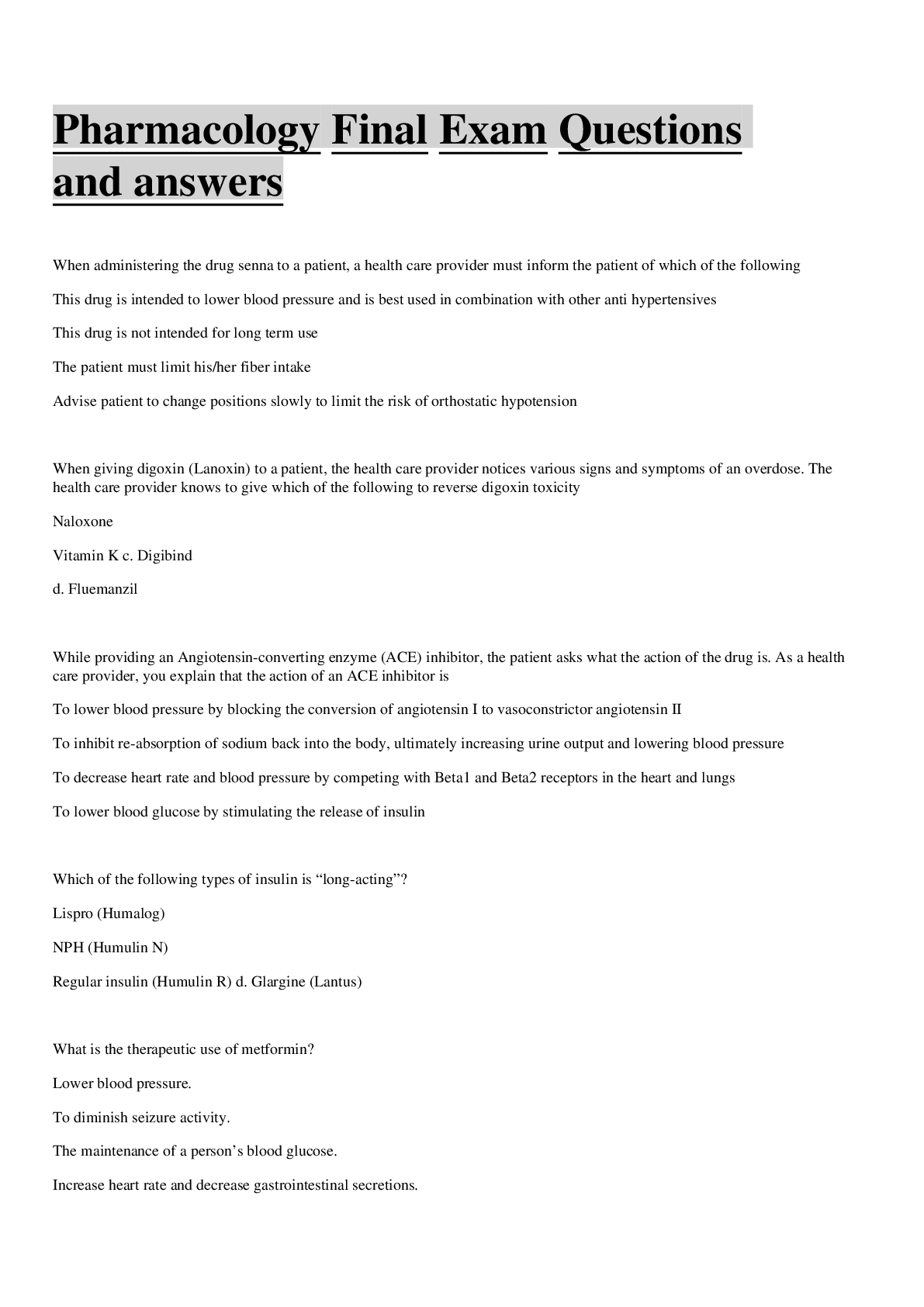
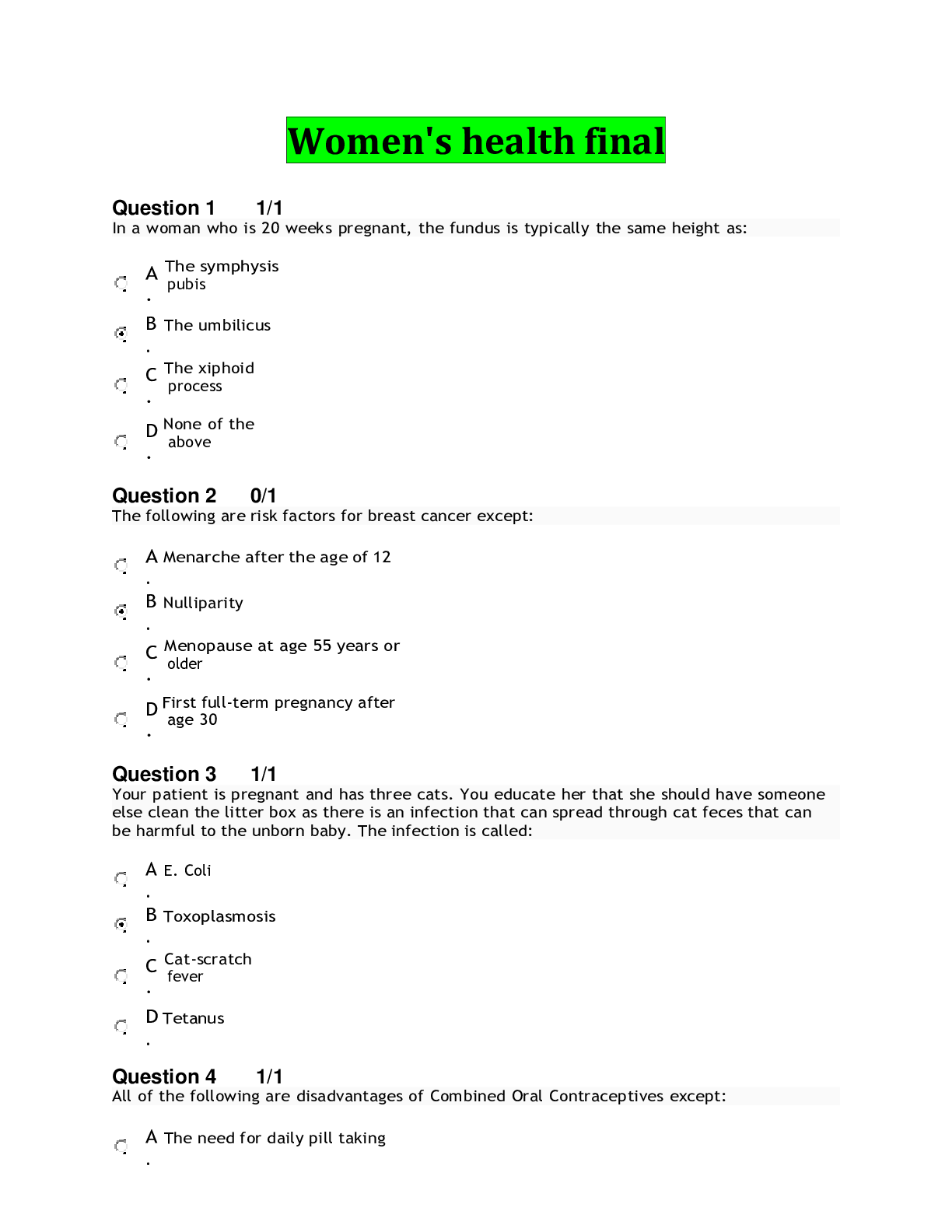


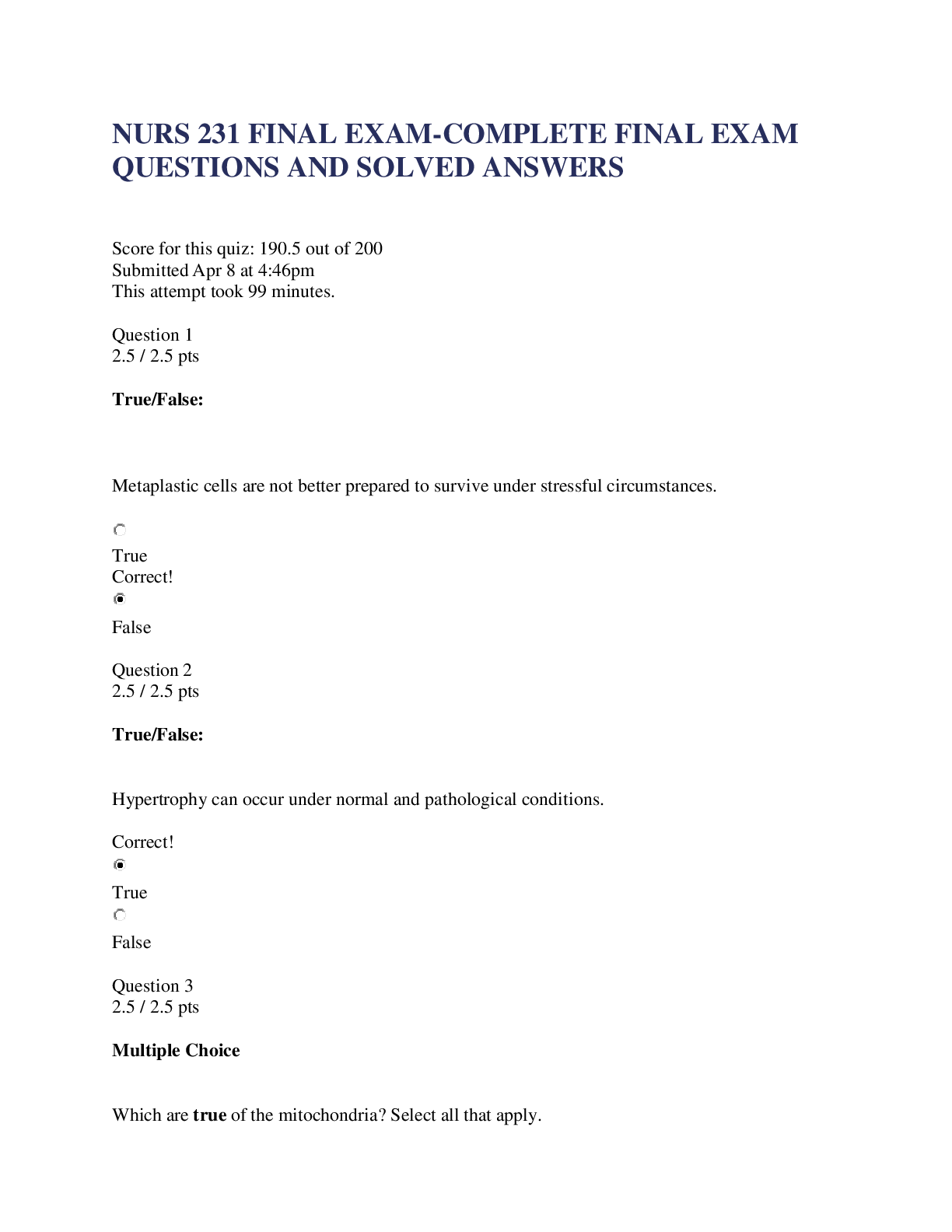
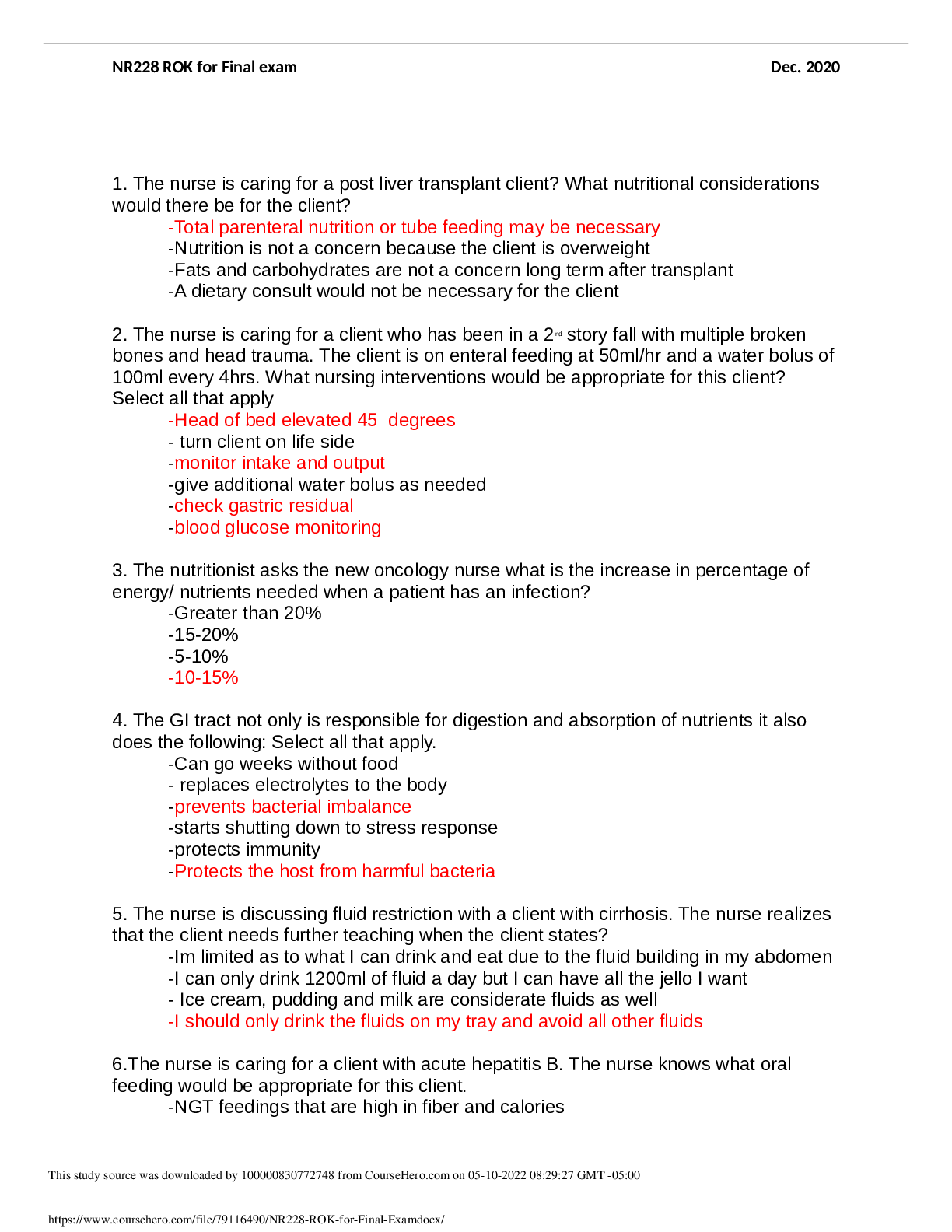

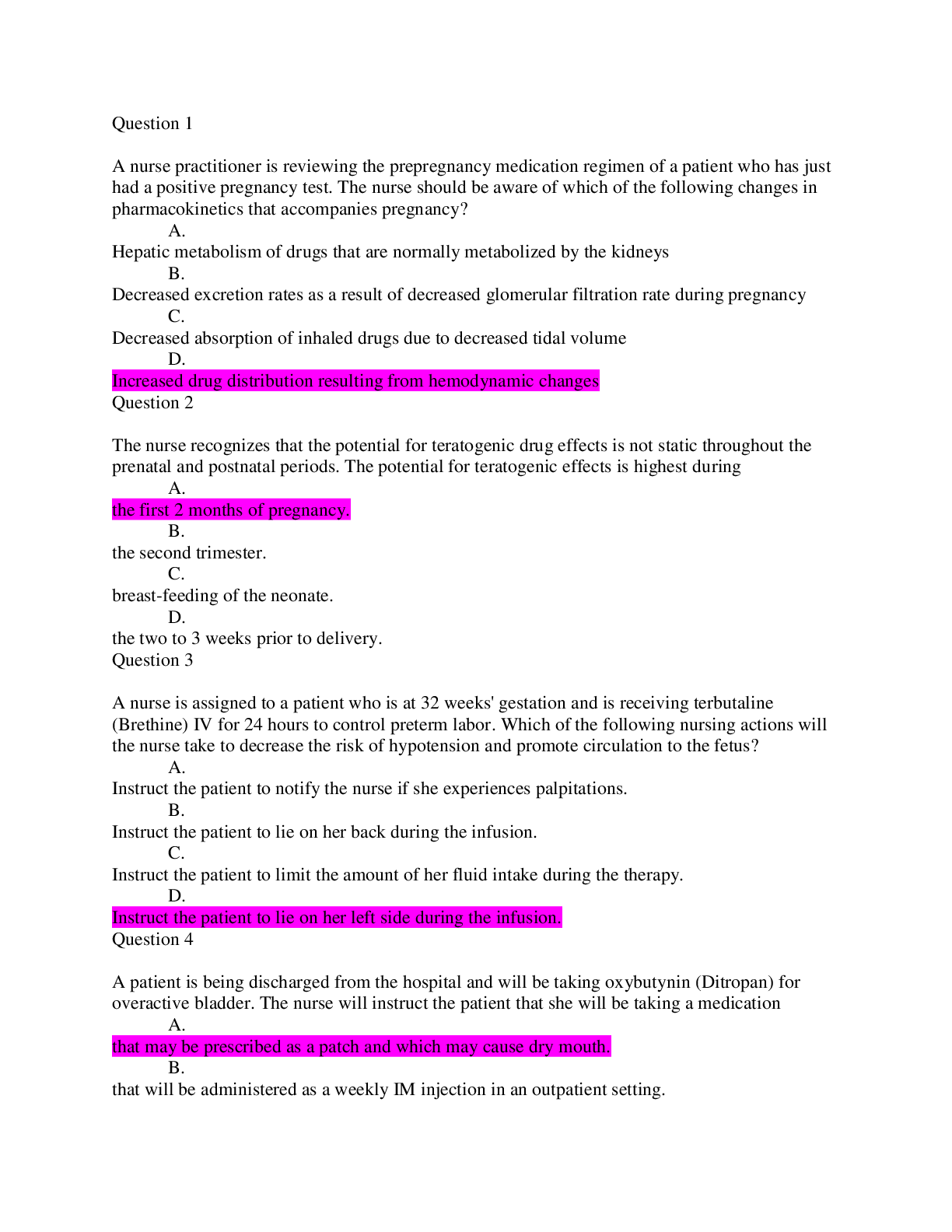
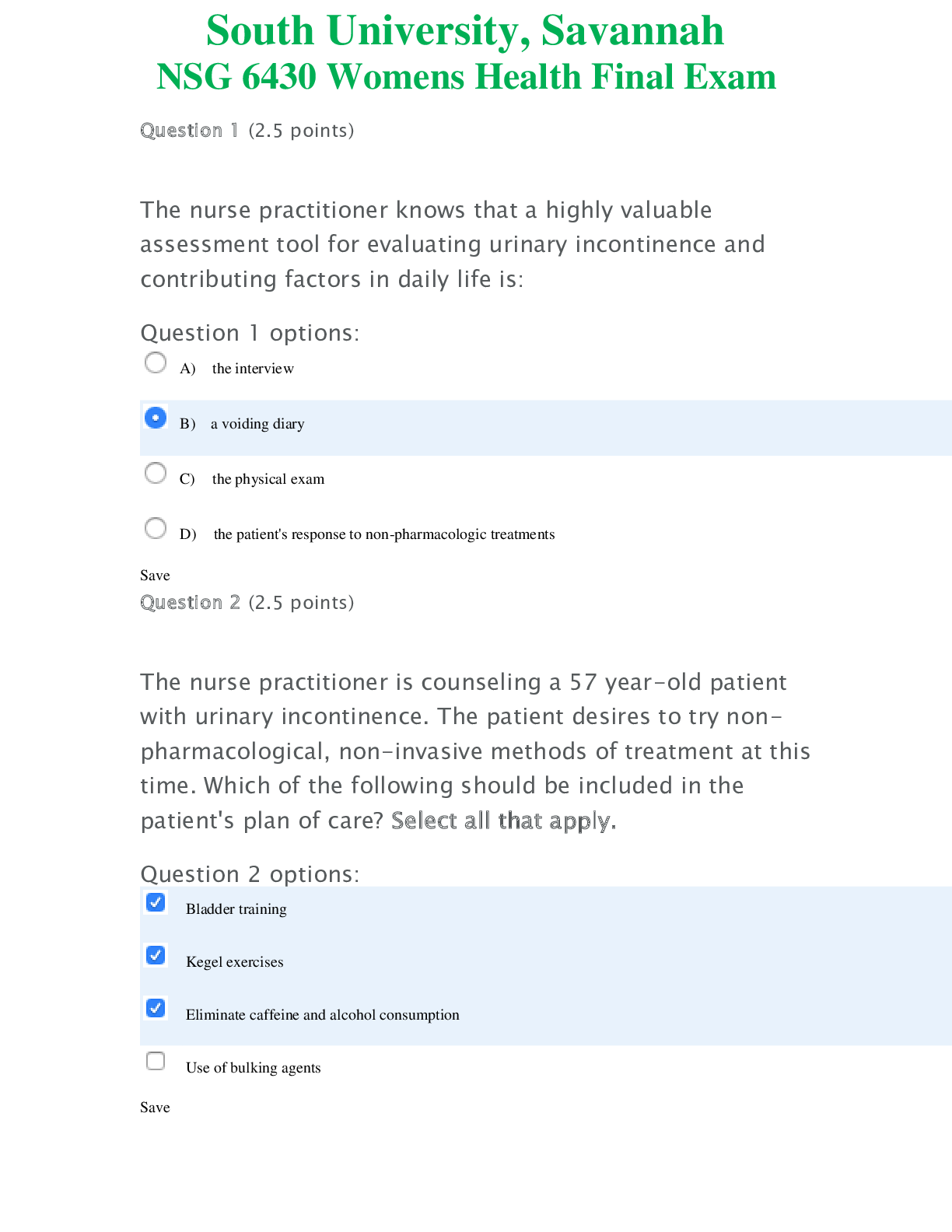
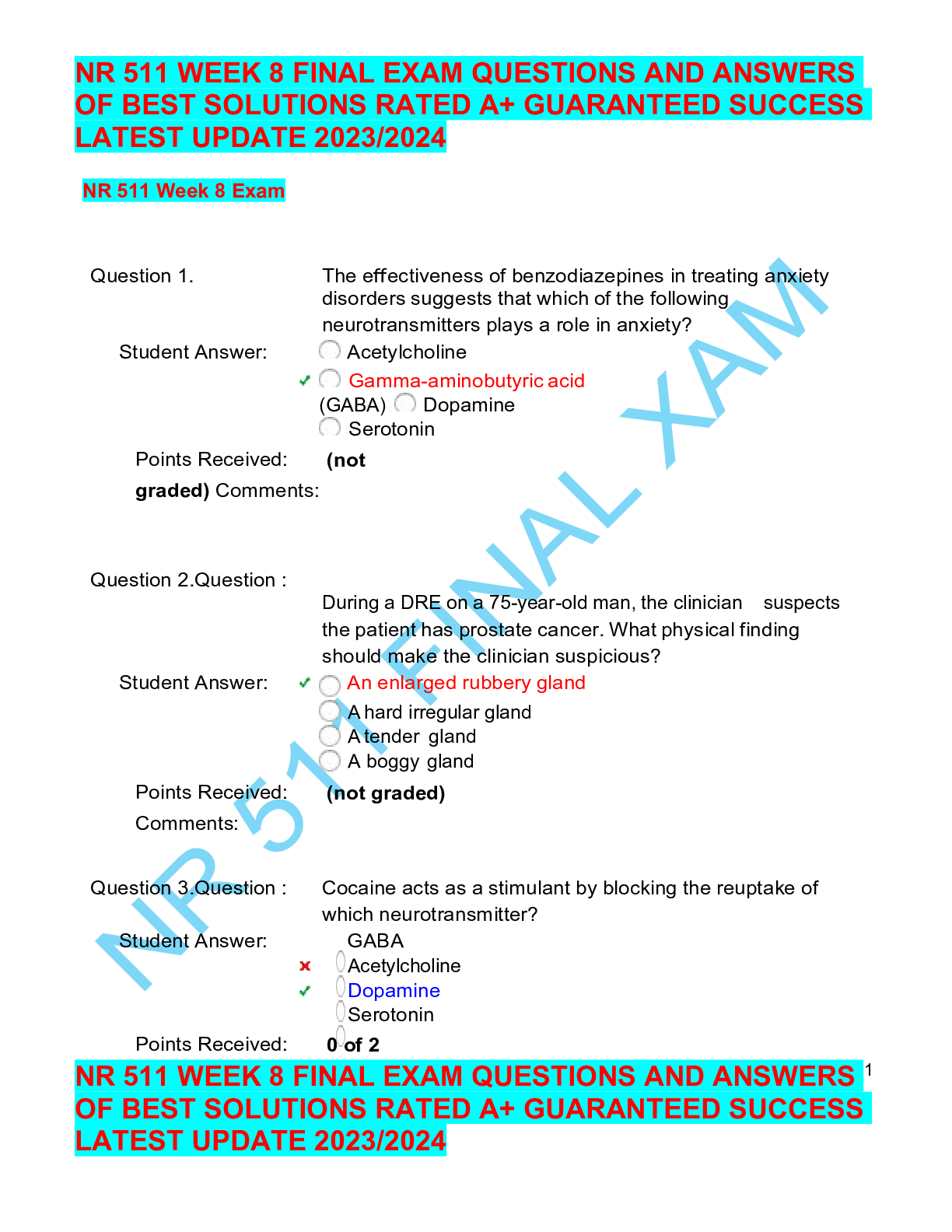
.png)
